- Privacy Policy
Buy Me a Coffee

Home » How to Publish a Research Paper – Step by Step Guide

How to Publish a Research Paper – Step by Step Guide
Table of Contents

Publishing a research paper is an important step for researchers to disseminate their findings to a wider audience and contribute to the advancement of knowledge in their field. Whether you are a graduate student, a postdoctoral fellow, or an established researcher, publishing a paper requires careful planning, rigorous research, and clear writing. In this process, you will need to identify a research question , conduct a thorough literature review , design a methodology, analyze data, and draw conclusions. Additionally, you will need to consider the appropriate journals or conferences to submit your work to and adhere to their guidelines for formatting and submission. In this article, we will discuss some ways to publish your Research Paper.
How to Publish a Research Paper
To Publish a Research Paper follow the guide below:
- Conduct original research : Conduct thorough research on a specific topic or problem. Collect data, analyze it, and draw conclusions based on your findings.
- Write the paper : Write a detailed paper describing your research. It should include an abstract, introduction, literature review, methodology, results, discussion, and conclusion.
- Choose a suitable journal or conference : Look for a journal or conference that specializes in your research area. You can check their submission guidelines to ensure your paper meets their requirements.
- Prepare your submission: Follow the guidelines and prepare your submission, including the paper, abstract, cover letter, and any other required documents.
- Submit the paper: Submit your paper online through the journal or conference website. Make sure you meet the submission deadline.
- Peer-review process : Your paper will be reviewed by experts in the field who will provide feedback on the quality of your research, methodology, and conclusions.
- Revisions : Based on the feedback you receive, revise your paper and resubmit it.
- Acceptance : Once your paper is accepted, you will receive a notification from the journal or conference. You may need to make final revisions before the paper is published.
- Publication : Your paper will be published online or in print. You can also promote your work through social media or other channels to increase its visibility.
How to Choose Journal for Research Paper Publication
Here are some steps to follow to help you select an appropriate journal:
- Identify your research topic and audience : Your research topic and intended audience should guide your choice of journal. Identify the key journals in your field of research and read the scope and aim of the journal to determine if your paper is a good fit.
- Analyze the journal’s impact and reputation : Check the impact factor and ranking of the journal, as well as its acceptance rate and citation frequency. A high-impact journal can give your paper more visibility and credibility.
- Consider the journal’s publication policies : Look for the journal’s publication policies such as the word count limit, formatting requirements, open access options, and submission fees. Make sure that you can comply with the requirements and that the journal is in line with your publication goals.
- Look at recent publications : Review recent issues of the journal to evaluate whether your paper would fit in with the journal’s current content and style.
- Seek advice from colleagues and mentors: Ask for recommendations and suggestions from your colleagues and mentors in your field, especially those who have experience publishing in the same or similar journals.
- Be prepared to make changes : Be prepared to revise your paper according to the requirements and guidelines of the chosen journal. It is also important to be open to feedback from the editor and reviewers.
List of Journals for Research Paper Publications
There are thousands of academic journals covering various fields of research. Here are some of the most popular ones, categorized by field:
General/Multidisciplinary
- Nature: https://www.nature.com/
- Science: https://www.sciencemag.org/
- PLOS ONE: https://journals.plos.org/plosone/
- Proceedings of the National Academy of Sciences (PNAS): https://www.pnas.org/
- The Lancet: https://www.thelancet.com/
- JAMA (Journal of the American Medical Association): https://jamanetwork.com/journals/jama
Social Sciences/Humanities
- Journal of Personality and Social Psychology: https://www.apa.org/pubs/journals/psp
- Journal of Consumer Research: https://www.journals.uchicago.edu/journals/jcr
- Journal of Educational Psychology: https://www.apa.org/pubs/journals/edu
- Journal of Applied Psychology: https://www.apa.org/pubs/journals/apl
- Journal of Communication: https://academic.oup.com/joc
- American Journal of Political Science: https://ajps.org/
- Journal of International Business Studies: https://www.jibs.net/
- Journal of Marketing Research: https://www.ama.org/journal-of-marketing-research/
Natural Sciences
- Journal of Biological Chemistry: https://www.jbc.org/
- Cell: https://www.cell.com/
- Science Advances: https://advances.sciencemag.org/
- Chemical Reviews: https://pubs.acs.org/journal/chreay
- Angewandte Chemie: https://onlinelibrary.wiley.com/journal/15213765
- Physical Review Letters: https://journals.aps.org/prl/
- Journal of Geophysical Research: https://agupubs.onlinelibrary.wiley.com/journal/2156531X
- Journal of High Energy Physics: https://link.springer.com/journal/13130
Engineering/Technology
- IEEE Transactions on Neural Networks and Learning Systems: https://ieeexplore.ieee.org/xpl/RecentIssue.jsp?punumber=5962385
- IEEE Transactions on Power Systems: https://ieeexplore.ieee.org/xpl/RecentIssue.jsp?punumber=59
- IEEE Transactions on Medical Imaging: https://ieeexplore.ieee.org/xpl/RecentIssue.jsp?punumber=42
- IEEE Transactions on Control Systems Technology: https://ieeexplore.ieee.org/xpl/RecentIssue.jsp?punumber=87
- Journal of Engineering Mechanics: https://ascelibrary.org/journal/jenmdt
- Journal of Materials Science: https://www.springer.com/journal/10853
- Journal of Chemical Engineering of Japan: https://www.jstage.jst.go.jp/browse/jcej
- Journal of Mechanical Design: https://asmedigitalcollection.asme.org/mechanicaldesign
Medical/Health Sciences
- New England Journal of Medicine: https://www.nejm.org/
- The BMJ (formerly British Medical Journal): https://www.bmj.com/
- Journal of the American Medical Association (JAMA): https://jamanetwork.com/journals/jama
- Annals of Internal Medicine: https://www.acpjournals.org/journal/aim
- American Journal of Epidemiology: https://academic.oup.com/aje
- Journal of Clinical Oncology: https://ascopubs.org/journal/jco
- Journal of Infectious Diseases: https://academic.oup.com/jid
List of Conferences for Research Paper Publications
There are many conferences that accept research papers for publication. The specific conferences you should consider will depend on your field of research. Here are some suggestions for conferences in a few different fields:
Computer Science and Information Technology:
- IEEE International Conference on Computer Communications (INFOCOM): https://www.ieee-infocom.org/
- ACM SIGCOMM Conference on Data Communication: https://conferences.sigcomm.org/sigcomm/
- IEEE Symposium on Security and Privacy (SP): https://www.ieee-security.org/TC/SP/
- ACM Conference on Computer and Communications Security (CCS): https://www.sigsac.org/ccs/
- ACM Conference on Human-Computer Interaction (CHI): https://chi2022.acm.org/
Engineering:
- IEEE International Conference on Robotics and Automation (ICRA): https://www.ieee-icra.org/
- International Conference on Mechanical and Aerospace Engineering (ICMAE): http://www.icmae.org/
- International Conference on Civil and Environmental Engineering (ICCEE): http://www.iccee.org/
- International Conference on Materials Science and Engineering (ICMSE): http://www.icmse.org/
- International Conference on Energy and Power Engineering (ICEPE): http://www.icepe.org/
Natural Sciences:
- American Chemical Society National Meeting & Exposition: https://www.acs.org/content/acs/en/meetings/national-meeting.html
- American Physical Society March Meeting: https://www.aps.org/meetings/march/
- International Conference on Environmental Science and Technology (ICEST): http://www.icest.org/
- International Conference on Natural Science and Environment (ICNSE): http://www.icnse.org/
- International Conference on Life Science and Biological Engineering (LSBE): http://www.lsbe.org/
Social Sciences:
- Annual Meeting of the American Sociological Association (ASA): https://www.asanet.org/annual-meeting-2022
- International Conference on Social Science and Humanities (ICSSH): http://www.icssh.org/
- International Conference on Psychology and Behavioral Sciences (ICPBS): http://www.icpbs.org/
- International Conference on Education and Social Science (ICESS): http://www.icess.org/
- International Conference on Management and Information Science (ICMIS): http://www.icmis.org/
How to Publish a Research Paper in Journal
Publishing a research paper in a journal is a crucial step in disseminating scientific knowledge and contributing to the field. Here are the general steps to follow:
- Choose a research topic : Select a topic of your interest and identify a research question or problem that you want to investigate. Conduct a literature review to identify the gaps in the existing knowledge that your research will address.
- Conduct research : Develop a research plan and methodology to collect data and conduct experiments. Collect and analyze data to draw conclusions that address the research question.
- Write a paper: Organize your findings into a well-structured paper with clear and concise language. Your paper should include an introduction, literature review, methodology, results, discussion, and conclusion. Use academic language and provide references for your sources.
- Choose a journal: Choose a journal that is relevant to your research topic and audience. Consider factors such as impact factor, acceptance rate, and the reputation of the journal.
- Follow journal guidelines : Review the submission guidelines and formatting requirements of the journal. Follow the guidelines carefully to ensure that your paper meets the journal’s requirements.
- Submit your paper : Submit your paper to the journal through the online submission system or by email. Include a cover letter that briefly explains the significance of your research and why it is suitable for the journal.
- Wait for reviews: Your paper will be reviewed by experts in the field. Be prepared to address their comments and make revisions to your paper.
- Revise and resubmit: Make revisions to your paper based on the reviewers’ comments and resubmit it to the journal. If your paper is accepted, congratulations! If not, consider revising and submitting it to another journal.
- Address reviewer comments : Reviewers may provide comments and suggestions for revisions to your paper. Address these comments carefully and thoughtfully to improve the quality of your paper.
- Submit the final version: Once your revisions are complete, submit the final version of your paper to the journal. Be sure to follow any additional formatting guidelines and requirements provided by the journal.
- Publication : If your paper is accepted, it will be published in the journal. Some journals provide online publication while others may publish a print version. Be sure to cite your published paper in future research and communicate your findings to the scientific community.
How to Publish a Research Paper for Students
Here are some steps you can follow to publish a research paper as an Under Graduate or a High School Student:
- Select a topic: Choose a topic that is relevant and interesting to you, and that you have a good understanding of.
- Conduct research : Gather information and data on your chosen topic through research, experiments, surveys, or other means.
- Write the paper : Start with an outline, then write the introduction, methods, results, discussion, and conclusion sections of the paper. Be sure to follow any guidelines provided by your instructor or the journal you plan to submit to.
- Edit and revise: Review your paper for errors in spelling, grammar, and punctuation. Ask a peer or mentor to review your paper and provide feedback for improvement.
- Choose a journal : Look for journals that publish papers in your field of study and that are appropriate for your level of research. Some popular journals for students include PLOS ONE, Nature, and Science.
- Submit the paper: Follow the submission guidelines for the journal you choose, which typically include a cover letter, abstract, and formatting requirements. Be prepared to wait several weeks to months for a response.
- Address feedback : If your paper is accepted with revisions, address the feedback from the reviewers and resubmit your paper. If your paper is rejected, review the feedback and consider revising and resubmitting to a different journal.
How to Publish a Research Paper for Free
Publishing a research paper for free can be challenging, but it is possible. Here are some steps you can take to publish your research paper for free:
- Choose a suitable open-access journal: Look for open-access journals that are relevant to your research area. Open-access journals allow readers to access your paper without charge, so your work will be more widely available.
- Check the journal’s reputation : Before submitting your paper, ensure that the journal is reputable by checking its impact factor, publication history, and editorial board.
- Follow the submission guidelines : Every journal has specific guidelines for submitting papers. Make sure to follow these guidelines carefully to increase the chances of acceptance.
- Submit your paper : Once you have completed your research paper, submit it to the journal following their submission guidelines.
- Wait for the review process: Your paper will undergo a peer-review process, where experts in your field will evaluate your work. Be patient during this process, as it can take several weeks or even months.
- Revise your paper : If your paper is rejected, don’t be discouraged. Revise your paper based on the feedback you receive from the reviewers and submit it to another open-access journal.
- Promote your research: Once your paper is published, promote it on social media and other online platforms. This will increase the visibility of your work and help it reach a wider audience.
Journals and Conferences for Free Research Paper publications
Here are the websites of the open-access journals and conferences mentioned:
Open-Access Journals:
- PLOS ONE – https://journals.plos.org/plosone/
- BMC Research Notes – https://bmcresnotes.biomedcentral.com/
- Frontiers in… – https://www.frontiersin.org/
- Journal of Open Research Software – https://openresearchsoftware.metajnl.com/
- PeerJ – https://peerj.com/
Conferences:
- IEEE Global Communications Conference (GLOBECOM) – https://globecom2022.ieee-globecom.org/
- IEEE International Conference on Computer Communications (INFOCOM) – https://infocom2022.ieee-infocom.org/
- IEEE International Conference on Data Mining (ICDM) – https://www.ieee-icdm.org/
- ACM SIGCOMM Conference on Data Communication (SIGCOMM) – https://conferences.sigcomm.org/sigcomm/
- ACM Conference on Computer and Communications Security (CCS) – https://www.sigsac.org/ccs/CCS2022/
Importance of Research Paper Publication
Research paper publication is important for several reasons, both for individual researchers and for the scientific community as a whole. Here are some reasons why:
- Advancing scientific knowledge : Research papers provide a platform for researchers to present their findings and contribute to the body of knowledge in their field. These papers often contain novel ideas, experimental data, and analyses that can help to advance scientific understanding.
- Building a research career : Publishing research papers is an essential component of building a successful research career. Researchers are often evaluated based on the number and quality of their publications, and having a strong publication record can increase one’s chances of securing funding, tenure, or a promotion.
- Peer review and quality control: Publication in a peer-reviewed journal means that the research has been scrutinized by other experts in the field. This peer review process helps to ensure the quality and validity of the research findings.
- Recognition and visibility : Publishing a research paper can bring recognition and visibility to the researchers and their work. It can lead to invitations to speak at conferences, collaborations with other researchers, and media coverage.
- Impact on society : Research papers can have a significant impact on society by informing policy decisions, guiding clinical practice, and advancing technological innovation.
Advantages of Research Paper Publication
There are several advantages to publishing a research paper, including:
- Recognition: Publishing a research paper allows researchers to gain recognition for their work, both within their field and in the academic community as a whole. This can lead to new collaborations, invitations to conferences, and other opportunities to share their research with a wider audience.
- Career advancement : A strong publication record can be an important factor in career advancement, particularly in academia. Publishing research papers can help researchers secure funding, grants, and promotions.
- Dissemination of knowledge : Research papers are an important way to share new findings and ideas with the broader scientific community. By publishing their research, scientists can contribute to the collective body of knowledge in their field and help advance scientific understanding.
- Feedback and peer review : Publishing a research paper allows other experts in the field to provide feedback on the research, which can help improve the quality of the work and identify potential flaws or limitations. Peer review also helps ensure that research is accurate and reliable.
- Citation and impact : Published research papers can be cited by other researchers, which can help increase the impact and visibility of the research. High citation rates can also help establish a researcher’s reputation and credibility within their field.
About the author
Muhammad Hassan
Researcher, Academic Writer, Web developer
You may also like

How to Cite Research Paper – All Formats and...

Delimitations in Research – Types, Examples and...

Research Paper Format – Types, Examples and...

Research Design – Types, Methods and Examples

Research Paper Title – Writing Guide and Example

Research Paper Introduction – Writing Guide and...

The 5 Best Platforms to Publish Your Academic Research
Academic research is a central component of scientific advancements and breakthrough innovations. However, your research journey is complex and ever-changing. You must take into consideration funding options, how to securely store your information, choosing where to publish your research, finding manuscript peer reviewers, and many more.
To keep up with the change, you and other researchers require modern, easy-to-navigate research platforms to help you uncover, store, verify, compile, and share content, data, and important insights to continue to carry out breakthrough research.
This article explains how to identify the best platforms for publishing your research and gives you a list of five platforms to help you publish. Towards the end, you’ll also see a mention of how Orvium can further assist you with publishing.
How to Identify the Best Platforms for Publishing
When trying to identify the best platforms for publishing your research, you have to consider several factors, including:
- Does the platform support your research journey ? Can you collaborate with other authors and researchers, discover public groups and research papers and manuscripts (including Open Access work), view interactive graphs, images, tables, etc., track citations, and build a professional research profile?
- Is the platform easy to use ? Does it offer rich functionalities that are easy to understand, and if so, which ones?
- Does it use artificial intelligence and machine learning ? Automated actions (email alerts, etc.) can help you unlock breakthroughs faster and deliver deeper insights.
- What security and governance does it have ? Platforms must be secure and compliant according to local regulations since researchers often deal with sensitive data.
The 5 Best Platforms to Publish Academic Research
Researchgate.
ResearchGate is a platform hosting over 135 million publication pages with a community of 20 million scientists. The platform allows you to show off your work, access papers and advice from other researchers, make contacts and even find jobs. Some of its more prominent features include:
- Dedicated Q&A section with searchable keywords to target experts in your particular field or area of study
- Ability to create a personal profile page where you can display all research-specific details about yourself, including up to five pieces of work (including datasets and conference papers)
- In-depth stats on who reads your work and the ability to track your citations
- A private messaging service that allows you to send messages to other researchers
- A comments section to provide feedback when viewing a paper
- A “projects” section to tell others about your upcoming work.
In addition, it's completely free to use!
Academia is a research-sharing platform with over 178 million users, 29 million papers uploaded, and 87 million visitors per month. Their goal is to accelerate research in all fields, ensure that all research is available for free and that the sharing of knowledge is available in multiple formats (videos, datasets, code, short-form content, etc.). Some of their more prominent features include:
- Mentions and search alerts that notify you when another researcher cites, thanks, or acknowledges your work, and automatic reports of search queries
- Ability to create a personal profile page
- “Profile visitor” and “readers” features let you know the title and location of those who visit your profile or read your papers so you can learn about their research interests and get in touch
- A “grants” feature to allow you to find new grants and fellowships in your field
- Advanced research discovery tools allow you to see full texts and citations of millions of papers.
The platform is based on a “freemium” business model, which provides free access to research for everyone, and paid capabilities to subscribers.
ScienceOpen
ScienceOpen is a discovery platform that empowers researchers to make an impact in their communities. The platform is committed to Open Science, combining decades of experience in traditional publishing, computing, and academic research to provide free access to knowledge to drive creativity, innovation, and development. Some of their more prominent features include:
- You can publish your most recent paper as a preprint that’s citable and includes a DOI to share with peers immediately and enhance visibility
- A multidimensional search feature for articles with 18 filters and the ability to sort results by Altmetric scores , citations, date, and rating
- Ability to create a personal profile with minimal upkeep necessary
- Access to a suite of metrics (usage, citations, etc.) of your publications
- Ability to follow other researchers to stay up-to-date on their work and expand your network.
The platform is free to use, although some features (like publishing your preprint) may cost money.
IOPscience is a platform that embraces innovative technologies to make it easier for researchers to discover and access technical, scientific, and medical content while managing their own research content. They participate in several programs that offer researchers in developing countries several ways to gain access to journals at little or no cost. Some of their other features include:
- An enhanced search filtering feature allows you to find relevant research faster
- A social bookmarking feature allows you to interact with other researchers and share articles
- Ability to create a personal profile, customize your alerts, view recently published articles within your field or area of interest, and save relevant papers or articles
- Ability to receive email alerts and RSS feeds once new content is published.
IOPscience is free to use and functions on an Open Access policy, which you can check here .
Orvium is an open, community-based research platform that allows researchers, reviewers, and publishers to share, publish, review, and manage their research. Orvium protects your work with built-in blockchain integration to ensure that you maintain the copyright of your work and not only. Some of our more notable features include:
- Access to a modern web platform with Google indexing, notifications, and mobile-ready features
- Ability to manage your entire publication process, with control over when you submit, receive peer reviews, and publish your paper
- “Collaboration” and “full traceability” features allow you to track your profile impact, get in touch with other researchers, and have ownership over your work
- Recognition badges or economic rewards are given when you peer-review.
Orvium is completely free to use.
Orvium Makes Choosing a Platform Easy
No matter what platform or community you choose to be a part of, you now know what you need to look for when choosing one. You also learned about five excellent platforms where you can publish your academic research. Orvium will remain your one-stop-shop platform for all your research needs. Do you want to know how Orvium and our communities work? Check out our platform or contact us with any questions you may have.
Subscribe to our newsletter
Get the latest posts delivered right to your inbox.

Now check your inbox and click the link to confirm your subscription.
Please enter a valid email address
Oops! There was an error sending the email, please try later.
Leyre Martínez
Recommended for you.

How to Write a Research Funding Application | Orvium

Increasing Representation and Diversity in Research with Open Science | Orvium

Your Guide to Open Access Week 2023
- PRO Courses Guides New Tech Help Pro Expert Videos About wikiHow Pro Upgrade Sign In
- EDIT Edit this Article
- EXPLORE Tech Help Pro About Us Random Article Quizzes Request a New Article Community Dashboard This Or That Game Popular Categories Arts and Entertainment Artwork Books Movies Computers and Electronics Computers Phone Skills Technology Hacks Health Men's Health Mental Health Women's Health Relationships Dating Love Relationship Issues Hobbies and Crafts Crafts Drawing Games Education & Communication Communication Skills Personal Development Studying Personal Care and Style Fashion Hair Care Personal Hygiene Youth Personal Care School Stuff Dating All Categories Arts and Entertainment Finance and Business Home and Garden Relationship Quizzes Cars & Other Vehicles Food and Entertaining Personal Care and Style Sports and Fitness Computers and Electronics Health Pets and Animals Travel Education & Communication Hobbies and Crafts Philosophy and Religion Work World Family Life Holidays and Traditions Relationships Youth
- Browse Articles
- Learn Something New
- Quizzes Hot
- This Or That Game New
- Train Your Brain
- Explore More
- Support wikiHow
- About wikiHow
- Log in / Sign up
- Education and Communications
- College University and Postgraduate
- Academic Writing
- Research Papers
How to Write and Publish Your Research in a Journal
Last Updated: February 26, 2024 Fact Checked
Choosing a Journal
Writing the research paper, editing & revising your paper, submitting your paper, navigating the peer review process, research paper help.
This article was co-authored by Matthew Snipp, PhD and by wikiHow staff writer, Cheyenne Main . C. Matthew Snipp is the Burnet C. and Mildred Finley Wohlford Professor of Humanities and Sciences in the Department of Sociology at Stanford University. He is also the Director for the Institute for Research in the Social Science’s Secure Data Center. He has been a Research Fellow at the U.S. Bureau of the Census and a Fellow at the Center for Advanced Study in the Behavioral Sciences. He has published 3 books and over 70 articles and book chapters on demography, economic development, poverty and unemployment. He is also currently serving on the National Institute of Child Health and Development’s Population Science Subcommittee. He holds a Ph.D. in Sociology from the University of Wisconsin—Madison. There are 13 references cited in this article, which can be found at the bottom of the page. This article has been fact-checked, ensuring the accuracy of any cited facts and confirming the authority of its sources. This article has been viewed 697,487 times.
Publishing a research paper in a peer-reviewed journal allows you to network with other scholars, get your name and work into circulation, and further refine your ideas and research. Before submitting your paper, make sure it reflects all the work you’ve done and have several people read over it and make comments. Keep reading to learn how you can choose a journal, prepare your work for publication, submit it, and revise it after you get a response back.
Things You Should Know
- Create a list of journals you’d like to publish your work in and choose one that best aligns with your topic and your desired audience.
- Prepare your manuscript using the journal’s requirements and ask at least 2 professors or supervisors to review your paper.
- Write a cover letter that “sells” your manuscript, says how your research adds to your field and explains why you chose the specific journal you’re submitting to.

- Ask your professors or supervisors for well-respected journals that they’ve had good experiences publishing with and that they read regularly.
- Many journals also only accept specific formats, so by choosing a journal before you start, you can write your article to their specifications and increase your chances of being accepted.
- If you’ve already written a paper you’d like to publish, consider whether your research directly relates to a hot topic or area of research in the journals you’re looking into.

- Review the journal’s peer review policies and submission process to see if you’re comfortable creating or adjusting your work according to their standards.
- Open-access journals can increase your readership because anyone can access them.

- Scientific research papers: Instead of a “thesis,” you might write a “research objective” instead. This is where you state the purpose of your research.
- “This paper explores how George Washington’s experiences as a young officer may have shaped his views during difficult circumstances as a commanding officer.”
- “This paper contends that George Washington’s experiences as a young officer on the 1750s Pennsylvania frontier directly impacted his relationship with his Continental Army troops during the harsh winter at Valley Forge.”

- Scientific research papers: Include a “materials and methods” section with the step-by-step process you followed and the materials you used. [5] X Research source
- Read other research papers in your field to see how they’re written. Their format, writing style, subject matter, and vocabulary can help guide your own paper. [6] X Research source

- If you’re writing about George Washington’s experiences as a young officer, you might emphasize how this research changes our perspective of the first president of the U.S.
- Link this section to your thesis or research objective.
- If you’re writing a paper about ADHD, you might discuss other applications for your research.

- Scientific research papers: You might include your research and/or analytical methods, your main findings or results, and the significance or implications of your research.
- Try to get as many people as you can to read over your abstract and provide feedback before you submit your paper to a journal.

- They might also provide templates to help you structure your manuscript according to their specific guidelines. [11] X Research source

- Not all journal reviewers will be experts on your specific topic, so a non-expert “outsider’s perspective” can be valuable.

- If you have a paper on the purification of wastewater with fungi, you might use both the words “fungi” and “mushrooms.”
- Use software like iThenticate, Turnitin, or PlagScan to check for similarities between the submitted article and published material available online. [15] X Research source

- Header: Address the editor who will be reviewing your manuscript by their name, include the date of submission, and the journal you are submitting to.
- First paragraph: Include the title of your manuscript, the type of paper it is (like review, research, or case study), and the research question you wanted to answer and why.
- Second paragraph: Explain what was done in your research, your main findings, and why they are significant to your field.
- Third paragraph: Explain why the journal’s readers would be interested in your work and why your results are important to your field.
- Conclusion: State the author(s) and any journal requirements that your work complies with (like ethical standards”).
- “We confirm that this manuscript has not been published elsewhere and is not under consideration by another journal.”
- “All authors have approved the manuscript and agree with its submission to [insert the name of the target journal].”

- Submit your article to only one journal at a time.
- When submitting online, use your university email account. This connects you with a scholarly institution, which can add credibility to your work.

- Accept: Only minor adjustments are needed, based on the provided feedback by the reviewers. A first submission will rarely be accepted without any changes needed.
- Revise and Resubmit: Changes are needed before publication can be considered, but the journal is still very interested in your work.
- Reject and Resubmit: Extensive revisions are needed. Your work may not be acceptable for this journal, but they might also accept it if significant changes are made.
- Reject: The paper isn’t and won’t be suitable for this publication, but that doesn’t mean it might not work for another journal.

- Try organizing the reviewer comments by how easy it is to address them. That way, you can break your revisions down into more manageable parts.
- If you disagree with a comment made by a reviewer, try to provide an evidence-based explanation when you resubmit your paper.

- If you’re resubmitting your paper to the same journal, include a point-by-point response paper that talks about how you addressed all of the reviewers’ comments in your revision. [22] X Research source
- If you’re not sure which journal to submit to next, you might be able to ask the journal editor which publications they recommend.

Expert Q&A
You might also like.

- If reviewers suspect that your submitted manuscript plagiarizes another work, they may refer to a Committee on Publication Ethics (COPE) flowchart to see how to move forward. [23] X Research source Thanks Helpful 0 Not Helpful 0

- ↑ https://www.wiley.com/en-us/network/publishing/research-publishing/choosing-a-journal/6-steps-to-choosing-the-right-journal-for-your-research-infographic
- ↑ https://link.springer.com/article/10.1007/s13187-020-01751-z
- ↑ https://libguides.unomaha.edu/c.php?g=100510&p=651627
- ↑ http://www.canberra.edu.au/library/start-your-research/research_help/publishing-research
- ↑ https://writingcenter.fas.harvard.edu/conclusions
- ↑ https://writing.wisc.edu/handbook/assignments/writing-an-abstract-for-your-research-paper/
- ↑ https://www.springer.com/gp/authors-editors/book-authors-editors/your-publication-journey/manuscript-preparation
- ↑ https://apus.libanswers.com/writing/faq/2391
- ↑ https://academicguides.waldenu.edu/library/keyword/search-strategy
- ↑ https://ifis.libguides.com/journal-publishing-guide/submitting-your-paper
- ↑ https://www.springer.com/kr/authors-editors/authorandreviewertutorials/submitting-to-a-journal-and-peer-review/cover-letters/10285574
- ↑ http://www.apa.org/monitor/sep02/publish.aspx
- ↑ Matthew Snipp, PhD. Research Fellow, U.S. Bureau of the Census. Expert Interview. 26 March 2020.
About This Article

To publish a research paper, ask a colleague or professor to review your paper and give you feedback. Once you've revised your work, familiarize yourself with different academic journals so that you can choose the publication that best suits your paper. Make sure to look at the "Author's Guide" so you can format your paper according to the guidelines for that publication. Then, submit your paper and don't get discouraged if it is not accepted right away. You may need to revise your paper and try again. To learn about the different responses you might get from journals, see our reviewer's explanation below. Did this summary help you? Yes No
- Send fan mail to authors
Reader Success Stories
RAMDEV GOHIL
Oct 16, 2017
Did this article help you?
David Okandeji
Oct 23, 2019
Revati Joshi
Feb 13, 2017
Shahzad Khan
Jul 1, 2017
Apr 7, 2017

Featured Articles

Trending Articles

Watch Articles

- Terms of Use
- Privacy Policy
- Do Not Sell or Share My Info
- Not Selling Info
Get all the best how-tos!
Sign up for wikiHow's weekly email newsletter
Navigation group
Home banner.

Where scientists empower society
Creating solutions for healthy lives on a healthy planet.
most-cited publisher
largest publisher
2.5 billion
article views and downloads
Main Content
- Editors and reviewers
- Collaborators

Find a journal
We have a home for your research. Our community led journals cover more than 1,500 academic disciplines and are some of the largest and most cited in their fields.

Submit your research
Start your submission and get more impact for your research by publishing with us.

Author guidelines
Ready to publish? Check our author guidelines for everything you need to know about submitting, from choosing a journal and section to preparing your manuscript.

Peer review
Our efficient collaborative peer review means you’ll get a decision on your manuscript in an average of 61 days.

Article publishing charges (APCs) apply to articles that are accepted for publication by our external and independent editorial boards

Press office
Visit our press office for key media contact information, as well as Frontiers’ media kit, including our embargo policy, logos, key facts, leadership bios, and imagery.

Institutional partnerships
Join more than 555 institutions around the world already benefiting from an institutional membership with Frontiers, including CERN, Max Planck Society, and the University of Oxford.

Publishing partnerships
Partner with Frontiers and make your society’s transition to open access a reality with our custom-built platform and publishing expertise.

Policy Labs
Connecting experts from business, science, and policy to strengthen the dialogue between scientific research and informed policymaking.

How we publish
All Frontiers journals are community-run and fully open access, so every research article we publish is immediately and permanently free to read.

Editor guidelines
Reviewing a manuscript? See our guidelines for everything you need to know about our peer review process.

Become an editor
Apply to join an editorial board and collaborate with an international team of carefully selected independent researchers.

My assignments
It’s easy to find and track your editorial assignments with our platform, 'My Frontiers' – saving you time to spend on your own research.

Scientists call for urgent action to prevent immune-mediated illnesses caused by climate change and biodiversity loss
Climate change, pollution, and collapsing biodiversity are damaging our immune systems, but improving the environment offers effective and fast-acting protection.

Safeguarding peer review to ensure quality at scale
Making scientific research open has never been more important. But for research to be trusted, it must be of the highest quality. Facing an industry-wide rise in fraudulent science, Frontiers has increased its focus on safeguarding quality.

Chronic stress and inflammation linked to societal and environmental impacts in new study
Scientists hypothesize that as-yet unrecognized inflammatory stress is spreading among people at unprecedented rates, affecting our cognitive ability to address climate change, war, and other critical issues.

Tiny crustaceans discovered preying on live jellyfish during harsh Arctic night
Scientists used DNA metabarcoding to show for the first time that jellyfish are an important food for amphipods during the Arctic polar night in waters off Svalbard, at a time of year when other food resources are scarce.

Why studying astronauts’ microbiomes is crucial to ensure deep space mission success
In a new Frontiers’ guest editorial, Prof Dr Lembit Sihver, director of CRREAT at the Nuclear Physics Institute of the Czech Academy of Sciences and his co-authors explore the impact the microbiome has on human health in space.

Cake and cookies may increase Alzheimer’s risk: Here are five Frontiers articles you won’t want to miss
At Frontiers, we bring some of the world’s best research to a global audience. But with tens of thousands of articles published each year, it’s impossible to cover all of them. Here are just five amazing papers you may have missed.

2024's top 10 tech-driven Research Topics
Frontiers has compiled a list of 10 Research Topics that embrace the potential of technology to advance scientific breakthroughs and change the world for the better.
Get the latest research updates, subscribe to our newsletter
Home → Get Published → How to Publish a Research Paper: A Step-by-Step Guide
How to Publish a Research Paper: A Step-by-Step Guide
Jordan Kruszynski
- January 4, 2024

You’re in academia.
You’re going steady.
Your research is going well and you begin to wonder: ‘ How exactly do I get a research paper published?’
If this is the question on your lips, then this step-by-step guide is the one for you. We’ll be walking you through the whole process of how to publish a research paper.
Publishing a research paper is a significant milestone for researchers and academics, as it allows you to share your findings, contribute to your field of study, and start to gain serious recognition within the wider academic community. So, want to know how to publish a research paper? By following our guide, you’ll get a firm grasp of the steps involved in this process, giving you the best chance of successfully navigating the publishing process and getting your work out there.
Understanding the Publishing Process
To begin, it’s crucial to understand that getting a research paper published is a multi-step process. From beginning to end, it could take as little as 2 months before you see your paper nestled in the pages of your chosen journal. On the other hand, it could take as long as a year .
Below, we set out the steps before going into more detail on each one. Getting a feel for these steps will help you to visualise what lies ahead, and prepare yourself for each of them in turn. It’s important to remember that you won’t actually have control over every step – in fact, some of them will be decided by people you’ll probably never meet. However, knowing which parts of the process are yours to decide will allow you to adjust your approach and attitude accordingly.
Each of the following stages will play a vital role in the eventual publication of your paper:
- Preparing Your Research Paper
- Finding the Right Journal
- Crafting a Strong Manuscript
- Navigating the Peer-Review Process
- Submitting Your Paper
- Dealing with Rejections and Revising Your Paper
Step 1: Preparing Your Research Paper
It all starts here. The quality and content of your research paper is of fundamental importance if you want to get it published. This step will be different for every researcher depending on the nature of your research, but if you haven’t yet settled on a topic, then consider the following advice:
- Choose an interesting and relevant topic that aligns with current trends in your field. If your research touches on the passions and concerns of your academic peers or wider society, it may be more likely to capture attention and get published successfully.
- Conduct a comprehensive literature review (link to lit. review article once it’s published) to identify the state of existing research and any knowledge gaps within it. Aiming to fill a clear gap in the knowledge of your field is a great way to increase the practicality of your research and improve its chances of getting published.
- Structure your paper in a clear and organised manner, including all the necessary sections such as title, abstract, introduction (link to the ‘how to write a research paper intro’ article once it’s published) , methodology, results, discussion, and conclusion.
- Adhere to the formatting guidelines provided by your target journal to ensure that your paper is accepted as viable for publishing. More on this in the next section…
Step 2: Finding the Right Journal
Understanding how to publish a research paper involves selecting the appropriate journal for your work. This step is critical for successful publication, and you should take several factors into account when deciding which journal to apply for:
- Conduct thorough research to identify journals that specialise in your field of study and have published similar research. Naturally, if you submit a piece of research in molecular genetics to a journal that specialises in geology, you won’t be likely to get very far.
- Consider factors such as the journal’s scope, impact factor, and target audience. Today there is a wide array of journals to choose from, including traditional and respected print journals, as well as numerous online, open-access endeavours. Some, like Nature , even straddle both worlds.
- Review the submission guidelines provided by the journal and ensure your paper meets all the formatting requirements and word limits. This step is key. Nature, for example, offers a highly informative series of pages that tells you everything you need to know in order to satisfy their formatting guidelines (plus more on the whole submission process).
- Note that these guidelines can differ dramatically from journal to journal, and details really do matter. You might submit an outstanding piece of research, but if it includes, for example, images in the wrong size or format, this could mean a lengthy delay to getting it published. If you get everything right first time, you’ll save yourself a lot of time and trouble, as well as strengthen your publishing chances in the first place.
Step 3: Crafting a Strong Manuscript
Crafting a strong manuscript is crucial to impress journal editors and reviewers. Look at your paper as a complete package, and ensure that all the sections tie together to deliver your findings with clarity and precision.
- Begin by creating a clear and concise title that accurately reflects the content of your paper.
- Compose an informative abstract that summarises the purpose, methodology, results, and significance of your study.
- Craft an engaging introduction (link to the research paper introduction article) that draws your reader in.
- Develop a well-structured methodology section, presenting your results effectively using tables and figures.
- Write a compelling discussion and conclusion that emphasise the significance of your findings.
Step 4: Navigating the Peer-Review Process
Once you submit your research paper to a journal, it undergoes a rigorous peer-review process to ensure its quality and validity. In peer-review, experts in your field assess your research and provide feedback and suggestions for improvement, ultimately determining whether your paper is eligible for publishing or not. You are likely to encounter several models of peer-review, based on which party – author, reviewer, or both – remains anonymous throughout the process.
When your paper undergoes the peer-review process, be prepared for constructive criticism and address the comments you receive from your reviewer thoughtfully, providing clear and concise responses to their concerns or suggestions. These could make all the difference when it comes to making your next submission.
The peer-review process can seem like a closed book at times. Check out our discussion of the issue with philosopher and academic Amna Whiston in The Research Beat podcast!
Step 5: Submitting Your Paper
As we’ve already pointed out, one of the key elements in how to publish a research paper is ensuring that you meticulously follow the journal’s submission guidelines. Strive to comply with all formatting requirements, including citation styles, font, margins, and reference structure.
Before the final submission, thoroughly proofread your paper for errors, including grammar, spelling, and any inconsistencies in your data or analysis. At this stage, consider seeking feedback from colleagues or mentors to further improve the quality of your paper.
Step 6: Dealing with Rejections and Revising Your Paper
Rejection is a common part of the publishing process, but it shouldn’t discourage you. Analyse reviewer comments objectively and focus on the constructive feedback provided. Make necessary revisions and improvements to your paper to address the concerns raised by reviewers. If needed, consider submitting your paper to a different journal that is a better fit for your research.
For more tips on how to publish your paper out there, check out this thread by Dr. Asad Naveed ( @dr_asadnaveed ) – and if you need a refresher on the basics of how to publish under the Open Access model, watch this 5-minute video from Audemic Academy !
Final Thoughts
Successfully understanding how to publish a research paper requires dedication, attention to detail, and a systematic approach. By following the advice in our guide, you can increase your chances of navigating the publishing process effectively and achieving your goal of publication.
Remember, the journey may involve revisions, peer feedback, and potential rejections, but each step is an opportunity for growth and improvement. Stay persistent, maintain a positive mindset, and continue to refine your research paper until it reaches the standards of your target journal. Your contribution to your wider discipline through published research will not only advance your career, but also add to the growing body of collective knowledge in your field. Embrace the challenges and rewards that come with the publication process, and may your research paper make a significant impact in your area of study!
Looking for inspiration for your next big paper? Head to Audemic , where you can organise and listen to all the best and latest research in your field!
Keep striving, researchers! ✨
Table of Contents
Related articles.

You’re in academia. You’re going steady. Your research is going well and you begin to wonder: ‘How exactly do I get a

Behind the Scenes: What Does a Research Assistant Do?
Have you ever wondered what goes on behind the scenes in a research lab? Does it involve acting out the whims of

How to Write a Research Paper Introduction: Hook, Line, and Sinker
Want to know how to write a research paper introduction that dazzles? Struggling to hook your reader in with your opening sentences?

Blog Podcast
Privacy policy Terms of service
Subscribe to our newsletter!
Discover more from Audemic: Access any academic research via audio
Subscribe now to keep reading and get access to the full archive.
Type your email…
Continue reading
- Search Search
- CN (Chinese)
- DE (German)
- ES (Spanish)
- FR (Français)
- JP (Japanese)
- Open Research
- Booksellers
- Peer Reviewers
- Springer Nature Group ↗
Publish an article
- Roles and responsibilities
- Signing your contract
- Writing your manuscript
- Submitting your manuscript
- Producing your book
- Promoting your book
- Submit your book idea
- Manuscript guidelines
- Book author services
- Publish a book
- Publish conference proceedings
Join thousands of researchers worldwide that have published their work in one of our 3,000+ Springer Nature journals.
Step-by-step guide to article publishing
1. Prepare your article
- Make sure you follow the submission guidelines for that journal. Search for a journal .
- Get permission to use any images.
- Check that your data is easy to reproduce.
- State clearly if you're reusing any data that has been used elsewhere.
- Follow our policies on plagiarism and ethics .
- Use our services to get help with English translation, scientific assessment and formatting. Find out what support you can get .
2. Write a cover letter
- Introduce your work in a 1-page letter, explaining the research you did, and why it's relevant.
3. Submit your manuscript
- Go to the journal homepage to start the process
- You can only submit 1 article at a time to each journal. Duplicate submissions will be rejected.
4. Technical check
- We'll make sure that your article follows the journal guidelines for formatting, ethics, plagiarism, contributors, and permissions.
5. Editor and peer review
- The journal editor will read your article and decide if it's ready for peer review.
- Most articles will be reviewed by 2 or more experts in the field.
- They may contact you with questions at this point.
6. Final decision
- If your article is accepted, you'll need to sign a publishing agreement.
- If your article is rejected, you can get help finding another journal from our transfer desk team .
- If your article is open access, you'll need to pay a fee.
- Fees for OA publishing differ across journals. See relevant journal page for more information.
- You may be able to get help covering that cost. See information on funding .
- We'll send you proofs to approve, then we'll publish your article.
- Track your impact by logging in to your account
Get tips on preparing your manuscript using our submission checklist .
Each publication follows a slightly different process, so check the journal's guidelines for more details
Open access vs subscription publishing
Each of our journals has its own policies, options, and fees for publishing.
Over 600 of our journals are fully open access. Others use a hybrid model, with readers paying to access some articles.
Publishing your article open access has a number of benefits:
- Free to access and download
- Reaches a wider global audience
- 1.6x more citations
- 6x more downloads
- 4.9 average Altmetric attention (vs 2.1 subscription)
It's free to publish your article in a subscription journal, but there are fees for publishing open access articles. You'll need to check the open access fees for the journal you choose.
Learn more about open access
Get help with funding.
Many organisations require you to publish your research open access. It's worth checking with your supervisor and colleagues to understand your organisation's approach.
Many funders and institutions will cover your open access publishing fees. To find out if your fees are covered, take a look at our funding agreements .
We also offer discounts for researchers in some geographical regions. See regions with reduced fees
Learn more about funding
Choose a journal.
We have 3,000+ journals to choose from, covering a wide range of topics. The best way to find a relevant journal is to search by keyword.
Once you've chosen a journal, check the submission guidelines to see the open access fees.
Search all journals
Get support.
We offer editing, translation, data presentation and formatting services to help you at each step.
Author support for publishing
Knowledge resources for scientists, author tutorials.
If you have a question about a specific journal, check the submission guidelines. If you still need help, contact us .
- Tools & Services
- Account Development
- Sales and account contacts
- Professional
- Press office
- Locations & Contact
We are a world leading research, educational and professional publisher. Visit our main website for more information.
- © 2023 Springer Nature
- General terms and conditions
- Your US State Privacy Rights
- Your Privacy Choices / Manage Cookies
- Accessibility
- Legal notice
- Help us to improve this site, send feedback.
- SpringerLink shop
How to publish an article? – Step by step
If you plan to submit an article to one of our journals, or have any questions during the publication process, this helpdesk will guide you through manuscript submission, production and the services you can expect after your article’s publication.
1. Before you start
The following topics will be important during the early stages of writing your article.
- Publishing Ethics
- Open Access
- Impact Factor
- Rights, permissions and licensing
- Copyright and plagiarism
2. Turning your manuscript into an article
Preparation, publication.
- Find the right journal for your manuscript
- The Springer Journal Selector
- Manuscript preparation (reference styles, artwork guidelines, etc.)
Read more about Preparation
- Electronic submission
- Reviewing and acceptance
- Managing copyright – The "MyPublication" process
Read more about Submission
- Copy editing and language polishing
- Data processing and type setting
- Article Tracking
- Checking your article: proofing procedure
- e.Proofing – Makes editing easy!
Read more about Production
- Publishing your article "Online First"
- Publishing your article in a journal issue
Read more about Publication
3. After publication
If your article has been published, the following topics are important for you:
- Abstracting & Indexing
- Online access to my article
- Citation Alert
- Book discounts
- Marketing to worldwide audiences
How to Write and Publish a Research Paper for a Peer-Reviewed Journal
- Open access
- Published: 30 April 2020
- Volume 36 , pages 909–913, ( 2021 )
Cite this article
You have full access to this open access article
- Clara Busse ORCID: orcid.org/0000-0002-0178-1000 1 &
- Ella August ORCID: orcid.org/0000-0001-5151-1036 1 , 2
267k Accesses
15 Citations
719 Altmetric
Explore all metrics
Communicating research findings is an essential step in the research process. Often, peer-reviewed journals are the forum for such communication, yet many researchers are never taught how to write a publishable scientific paper. In this article, we explain the basic structure of a scientific paper and describe the information that should be included in each section. We also identify common pitfalls for each section and recommend strategies to avoid them. Further, we give advice about target journal selection and authorship. In the online resource 1 , we provide an example of a high-quality scientific paper, with annotations identifying the elements we describe in this article.
Similar content being viewed by others

How to Choose the Right Journal

The Point Is…to Publish?

Some Opinions on the Review Process of Research Papers Destined for Publication
Ehsan Roohi & Omid Mahian
Avoid common mistakes on your manuscript.
Introduction
Writing a scientific paper is an important component of the research process, yet researchers often receive little formal training in scientific writing. This is especially true in low-resource settings. In this article, we explain why choosing a target journal is important, give advice about authorship, provide a basic structure for writing each section of a scientific paper, and describe common pitfalls and recommendations for each section. In the online resource 1 , we also include an annotated journal article that identifies the key elements and writing approaches that we detail here. Before you begin your research, make sure you have ethical clearance from all relevant ethical review boards.
Select a Target Journal Early in the Writing Process
We recommend that you select a “target journal” early in the writing process; a “target journal” is the journal to which you plan to submit your paper. Each journal has a set of core readers and you should tailor your writing to this readership. For example, if you plan to submit a manuscript about vaping during pregnancy to a pregnancy-focused journal, you will need to explain what vaping is because readers of this journal may not have a background in this topic. However, if you were to submit that same article to a tobacco journal, you would not need to provide as much background information about vaping.
Information about a journal’s core readership can be found on its website, usually in a section called “About this journal” or something similar. For example, the Journal of Cancer Education presents such information on the “Aims and Scope” page of its website, which can be found here: https://www.springer.com/journal/13187/aims-and-scope .
Peer reviewer guidelines from your target journal are an additional resource that can help you tailor your writing to the journal and provide additional advice about crafting an effective article [ 1 ]. These are not always available, but it is worth a quick web search to find out.
Identify Author Roles Early in the Process
Early in the writing process, identify authors, determine the order of authors, and discuss the responsibilities of each author. Standard author responsibilities have been identified by The International Committee of Medical Journal Editors (ICMJE) [ 2 ]. To set clear expectations about each team member’s responsibilities and prevent errors in communication, we also suggest outlining more detailed roles, such as who will draft each section of the manuscript, write the abstract, submit the paper electronically, serve as corresponding author, and write the cover letter. It is best to formalize this agreement in writing after discussing it, circulating the document to the author team for approval. We suggest creating a title page on which all authors are listed in the agreed-upon order. It may be necessary to adjust authorship roles and order during the development of the paper. If a new author order is agreed upon, be sure to update the title page in the manuscript draft.
In the case where multiple papers will result from a single study, authors should discuss who will author each paper. Additionally, authors should agree on a deadline for each paper and the lead author should take responsibility for producing an initial draft by this deadline.
Structure of the Introduction Section
The introduction section should be approximately three to five paragraphs in length. Look at examples from your target journal to decide the appropriate length. This section should include the elements shown in Fig. 1 . Begin with a general context, narrowing to the specific focus of the paper. Include five main elements: why your research is important, what is already known about the topic, the “gap” or what is not yet known about the topic, why it is important to learn the new information that your research adds, and the specific research aim(s) that your paper addresses. Your research aim should address the gap you identified. Be sure to add enough background information to enable readers to understand your study. Table 1 provides common introduction section pitfalls and recommendations for addressing them.

The main elements of the introduction section of an original research article. Often, the elements overlap
Methods Section
The purpose of the methods section is twofold: to explain how the study was done in enough detail to enable its replication and to provide enough contextual detail to enable readers to understand and interpret the results. In general, the essential elements of a methods section are the following: a description of the setting and participants, the study design and timing, the recruitment and sampling, the data collection process, the dataset, the dependent and independent variables, the covariates, the analytic approach for each research objective, and the ethical approval. The hallmark of an exemplary methods section is the justification of why each method was used. Table 2 provides common methods section pitfalls and recommendations for addressing them.
Results Section
The focus of the results section should be associations, or lack thereof, rather than statistical tests. Two considerations should guide your writing here. First, the results should present answers to each part of the research aim. Second, return to the methods section to ensure that the analysis and variables for each result have been explained.
Begin the results section by describing the number of participants in the final sample and details such as the number who were approached to participate, the proportion who were eligible and who enrolled, and the number of participants who dropped out. The next part of the results should describe the participant characteristics. After that, you may organize your results by the aim or by putting the most exciting results first. Do not forget to report your non-significant associations. These are still findings.
Tables and figures capture the reader’s attention and efficiently communicate your main findings [ 3 ]. Each table and figure should have a clear message and should complement, rather than repeat, the text. Tables and figures should communicate all salient details necessary for a reader to understand the findings without consulting the text. Include information on comparisons and tests, as well as information about the sample and timing of the study in the title, legend, or in a footnote. Note that figures are often more visually interesting than tables, so if it is feasible to make a figure, make a figure. To avoid confusing the reader, either avoid abbreviations in tables and figures, or define them in a footnote. Note that there should not be citations in the results section and you should not interpret results here. Table 3 provides common results section pitfalls and recommendations for addressing them.
Discussion Section
Opposite the introduction section, the discussion should take the form of a right-side-up triangle beginning with interpretation of your results and moving to general implications (Fig. 2 ). This section typically begins with a restatement of the main findings, which can usually be accomplished with a few carefully-crafted sentences.

Major elements of the discussion section of an original research article. Often, the elements overlap
Next, interpret the meaning or explain the significance of your results, lifting the reader’s gaze from the study’s specific findings to more general applications. Then, compare these study findings with other research. Are these findings in agreement or disagreement with those from other studies? Does this study impart additional nuance to well-accepted theories? Situate your findings within the broader context of scientific literature, then explain the pathways or mechanisms that might give rise to, or explain, the results.
Journals vary in their approach to strengths and limitations sections: some are embedded paragraphs within the discussion section, while some mandate separate section headings. Keep in mind that every study has strengths and limitations. Candidly reporting yours helps readers to correctly interpret your research findings.
The next element of the discussion is a summary of the potential impacts and applications of the research. Should these results be used to optimally design an intervention? Does the work have implications for clinical protocols or public policy? These considerations will help the reader to further grasp the possible impacts of the presented work.
Finally, the discussion should conclude with specific suggestions for future work. Here, you have an opportunity to illuminate specific gaps in the literature that compel further study. Avoid the phrase “future research is necessary” because the recommendation is too general to be helpful to readers. Instead, provide substantive and specific recommendations for future studies. Table 4 provides common discussion section pitfalls and recommendations for addressing them.
Follow the Journal’s Author Guidelines
After you select a target journal, identify the journal’s author guidelines to guide the formatting of your manuscript and references. Author guidelines will often (but not always) include instructions for titles, cover letters, and other components of a manuscript submission. Read the guidelines carefully. If you do not follow the guidelines, your article will be sent back to you.
Finally, do not submit your paper to more than one journal at a time. Even if this is not explicitly stated in the author guidelines of your target journal, it is considered inappropriate and unprofessional.
Your title should invite readers to continue reading beyond the first page [ 4 , 5 ]. It should be informative and interesting. Consider describing the independent and dependent variables, the population and setting, the study design, the timing, and even the main result in your title. Because the focus of the paper can change as you write and revise, we recommend you wait until you have finished writing your paper before composing the title.
Be sure that the title is useful for potential readers searching for your topic. The keywords you select should complement those in your title to maximize the likelihood that a researcher will find your paper through a database search. Avoid using abbreviations in your title unless they are very well known, such as SNP, because it is more likely that someone will use a complete word rather than an abbreviation as a search term to help readers find your paper.
After you have written a complete draft, use the checklist (Fig. 3 ) below to guide your revisions and editing. Additional resources are available on writing the abstract and citing references [ 5 ]. When you feel that your work is ready, ask a trusted colleague or two to read the work and provide informal feedback. The box below provides a checklist that summarizes the key points offered in this article.

Checklist for manuscript quality
Data Availability
Michalek AM (2014) Down the rabbit hole…advice to reviewers. J Cancer Educ 29:4–5
Article Google Scholar
International Committee of Medical Journal Editors. Defining the role of authors and contributors: who is an author? http://www.icmje.org/recommendations/browse/roles-and-responsibilities/defining-the-role-of-authosrs-and-contributors.html . Accessed 15 January, 2020
Vetto JT (2014) Short and sweet: a short course on concise medical writing. J Cancer Educ 29(1):194–195
Brett M, Kording K (2017) Ten simple rules for structuring papers. PLoS ComputBiol. https://doi.org/10.1371/journal.pcbi.1005619
Lang TA (2017) Writing a better research article. J Public Health Emerg. https://doi.org/10.21037/jphe.2017.11.06
Download references
Acknowledgments
Ella August is grateful to the Sustainable Sciences Institute for mentoring her in training researchers on writing and publishing their research.
Code Availability
Not applicable.
Author information
Authors and affiliations.
Department of Maternal and Child Health, University of North Carolina Gillings School of Global Public Health, 135 Dauer Dr, 27599, Chapel Hill, NC, USA
Clara Busse & Ella August
Department of Epidemiology, University of Michigan School of Public Health, 1415 Washington Heights, Ann Arbor, MI, 48109-2029, USA
Ella August
You can also search for this author in PubMed Google Scholar
Corresponding author
Correspondence to Ella August .
Ethics declarations
Conflicts of interests.
The authors declare that they have no conflict of interest.
Additional information
Publisher’s note.
Springer Nature remains neutral with regard to jurisdictional claims in published maps and institutional affiliations.
Electronic supplementary material
(PDF 362 kb)
Rights and permissions
Open Access This article is licensed under a Creative Commons Attribution 4.0 International License, which permits use, sharing, adaptation, distribution and reproduction in any medium or format, as long as you give appropriate credit to the original author(s) and the source, provide a link to the Creative Commons licence, and indicate if changes were made. The images or other third party material in this article are included in the article's Creative Commons licence, unless indicated otherwise in a credit line to the material. If material is not included in the article's Creative Commons licence and your intended use is not permitted by statutory regulation or exceeds the permitted use, you will need to obtain permission directly from the copyright holder. To view a copy of this licence, visit http://creativecommons.org/licenses/by/4.0/ .
Reprints and permissions
About this article
Busse, C., August, E. How to Write and Publish a Research Paper for a Peer-Reviewed Journal. J Canc Educ 36 , 909–913 (2021). https://doi.org/10.1007/s13187-020-01751-z
Download citation
Published : 30 April 2020
Issue Date : October 2021
DOI : https://doi.org/10.1007/s13187-020-01751-z
Share this article
Anyone you share the following link with will be able to read this content:
Sorry, a shareable link is not currently available for this article.
Provided by the Springer Nature SharedIt content-sharing initiative
- Manuscripts
- Scientific writing
- Find a journal
- Publish with us
- Track your research
You are using an outdated browser . Please upgrade your browser today !
How to Write and Publish a Research Paper in 7 Steps
What comes next after you're done with your research? Publishing the results in a journal of course! We tell you how to present your work in the best way possible.
This post is part of a series, which serves to provide hands-on information and resources for authors and editors.
Things have gotten busy in scholarly publishing: These days, a new article gets published in the 50,000 most important peer-reviewed journals every few seconds, while each one takes on average 40 minutes to read. Hundreds of thousands of papers reach the desks of editors and reviewers worldwide each year and 50% of all submissions end up rejected at some stage.
In a nutshell: there is a lot of competition, and the people who decide upon the fate of your manuscript are short on time and overworked. But there are ways to make their lives a little easier and improve your own chances of getting your work published!
Well, it may seem obvious, but before submitting an academic paper, always make sure that it is an excellent reflection of the research you have done and that you present it in the most professional way possible. Incomplete or poorly presented manuscripts can create a great deal of frustration and annoyance for editors who probably won’t even bother wasting the time of the reviewers!
This post will discuss 7 steps to the successful publication of your research paper:
- Check whether your research is publication-ready
- Choose an article type
- Choose a journal
- Construct your paper
- Decide the order of authors
- Check and double-check
- Submit your paper
1. Check Whether Your Research Is Publication-Ready
Should you publish your research at all?
If your work holds academic value – of course – a well-written scholarly article could open doors to your research community. However, if you are not yet sure, whether your research is ready for publication, here are some key questions to ask yourself depending on your field of expertise:
- Have you done or found something new and interesting? Something unique?
- Is the work directly related to a current hot topic?
- Have you checked the latest results or research in the field?
- Have you provided solutions to any difficult problems?
- Have the findings been verified?
- Have the appropriate controls been performed if required?
- Are your findings comprehensive?
If the answers to all relevant questions are “yes”, you need to prepare a good, strong manuscript. Remember, a research paper is only useful if it is clearly understood, reproducible and if it is read and used .

2. Choose An Article Type
The first step is to determine which type of paper is most appropriate for your work and what you want to achieve. The following list contains the most important, usually peer-reviewed article types in the natural sciences:
Full original research papers disseminate completed research findings. On average this type of paper is 8-10 pages long, contains five figures, and 25-30 references. Full original research papers are an important part of the process when developing your career.
Review papers present a critical synthesis of a specific research topic. These papers are usually much longer than original papers and will contain numerous references. More often than not, they will be commissioned by journal editors. Reviews present an excellent way to solidify your research career.
Letters, Rapid or Short Communications are often published for the quick and early communication of significant and original advances. They are much shorter than full articles and usually limited in length by the journal. Journals specifically dedicated to short communications or letters are also published in some fields. In these the authors can present short preliminary findings before developing a full-length paper.
3. Choose a Journal
Are you looking for the right place to publish your paper? Find out here whether a De Gruyter journal might be the right fit.
Submit to journals that you already read, that you have a good feel for. If you do so, you will have a better appreciation of both its culture and the requirements of the editors and reviewers.
Other factors to consider are:
- The specific subject area
- The aims and scope of the journal
- The type of manuscript you have written
- The significance of your work
- The reputation of the journal
- The reputation of the editors within the community
- The editorial/review and production speeds of the journal
- The community served by the journal
- The coverage and distribution
- The accessibility ( open access vs. closed access)
4. Construct Your Paper
Each element of a paper has its purpose, so you should make these sections easy to index and search.
Don’t forget that requirements can differ highly per publication, so always make sure to apply a journal’s specific instructions – or guide – for authors to your manuscript, even to the first draft (text layout, paper citation, nomenclature, figures and table, etc.) It will save you time, and the editor’s.
Also, even in these days of Internet-based publishing, space is still at a premium, so be as concise as possible. As a good journalist would say: “Never use three words when one will do!”
Let’s look at the typical structure of a full research paper, but bear in mind certain subject disciplines may have their own specific requirements so check the instructions for authors on the journal’s home page.
4.1 The Title
It’s important to use the title to tell the reader what your paper is all about! You want to attract their attention, a bit like a newspaper headline does. Be specific and to the point. Keep it informative and concise, and avoid jargon and abbreviations (unless they are universally recognized like DNA, for example).
4.2 The Abstract
This could be termed as the “advertisement” for your article. Make it interesting and easily understood without the reader having to read the whole article. Be accurate and specific, and keep it as brief and concise as possible. Some journals (particularly in the medical fields) will ask you to structure the abstract in distinct, labeled sections, which makes it even more accessible.
A clear abstract will influence whether or not your work is considered and whether an editor should invest more time on it or send it for review.
4.3 Keywords
Keywords are used by abstracting and indexing services, such as PubMed and Web of Science. They are the labels of your manuscript, which make it “searchable” online by other researchers.
Include words or phrases (usually 4-8) that are closely related to your topic but not “too niche” for anyone to find them. Make sure to only use established abbreviations. Think about what scientific terms and its variations your potential readers are likely to use and search for. You can also do a test run of your selected keywords in one of the common academic search engines. Do similar articles to your own appear? Yes? Then that’s a good sign.
4.4 Introduction
This first part of the main text should introduce the problem, as well as any existing solutions you are aware of and the main limitations. Also, state what you hope to achieve with your research.
Do not confuse the introduction with the results, discussion or conclusion.
4.5 Methods
Every research article should include a detailed Methods section (also referred to as “Materials and Methods”) to provide the reader with enough information to be able to judge whether the study is valid and reproducible.
Include detailed information so that a knowledgeable reader can reproduce the experiment. However, use references and supplementary materials to indicate previously published procedures.
4.6 Results
In this section, you will present the essential or primary results of your study. To display them in a comprehensible way, you should use subheadings as well as illustrations such as figures, graphs, tables and photos, as appropriate.
4.7 Discussion
Here you should tell your readers what the results mean .
Do state how the results relate to the study’s aims and hypotheses and how the findings relate to those of other studies. Explain all possible interpretations of your findings and the study’s limitations.
Do not make “grand statements” that are not supported by the data. Also, do not introduce any new results or terms. Moreover, do not ignore work that conflicts or disagrees with your findings. Instead …
Be brave! Address conflicting study results and convince the reader you are the one who is correct.
4.8 Conclusion
Your conclusion isn’t just a summary of what you’ve already written. It should take your paper one step further and answer any unresolved questions.
Sum up what you have shown in your study and indicate possible applications and extensions. The main question your conclusion should answer is: What do my results mean for the research field and my community?
4.9 Acknowledgments and Ethical Statements
It is extremely important to acknowledge anyone who has helped you with your paper, including researchers who supplied materials or reagents (e.g. vectors or antibodies); and anyone who helped with the writing or English, or offered critical comments about the content.
Learn more about academic integrity in our blog post “Scholarly Publication Ethics: 4 Common Mistakes You Want To Avoid” .
Remember to state why people have been acknowledged and ask their permission . Ensure that you acknowledge sources of funding, including any grant or reference numbers.
Furthermore, if you have worked with animals or humans, you need to include information about the ethical approval of your study and, if applicable, whether informed consent was given. Also, state whether you have any competing interests regarding the study (e.g. because of financial or personal relationships.)
4.10 References
The end is in sight, but don’t relax just yet!
De facto, there are often more mistakes in the references than in any other part of the manuscript. It is also one of the most annoying and time-consuming problems for editors.
Remember to cite the main scientific publications on which your work is based. But do not inflate the manuscript with too many references. Avoid excessive – and especially unnecessary – self-citations. Also, avoid excessive citations of publications from the same institute or region.
5. Decide the Order of Authors
In the sciences, the most common way to order the names of the authors is by relative contribution.
Generally, the first author conducts and/or supervises the data analysis and the proper presentation and interpretation of the results. They put the paper together and usually submit the paper to the journal.
Co-authors make intellectual contributions to the data analysis and contribute to data interpretation. They review each paper draft. All of them must be able to present the paper and its results, as well as to defend the implications and discuss study limitations.
Do not leave out authors who should be included or add “gift authors”, i.e. authors who did not contribute significantly.
6. Check and Double-Check
As a final step before submission, ask colleagues to read your work and be constructively critical .
Make sure that the paper is appropriate for the journal – take a last look at their aims and scope. Check if all of the requirements in the instructions for authors are met.
Ensure that the cited literature is balanced. Are the aims, purpose and significance of the results clear?
Conduct a final check for language, either by a native English speaker or an editing service.
7. Submit Your Paper
When you and your co-authors have double-, triple-, quadruple-checked the manuscript: submit it via e-mail or online submission system. Along with your manuscript, submit a cover letter, which highlights the reasons why your paper would appeal to the journal and which ensures that you have received approval of all authors for submission.
It is up to the editors and the peer-reviewers now to provide you with their (ideally constructive and helpful) comments and feedback. Time to take a breather!
If the paper gets rejected, do not despair – it happens to literally everybody. If the journal suggests major or minor revisions, take the chance to provide a thorough response and make improvements as you see fit. If the paper gets accepted, congrats!
It’s now time to get writing and share your hard work – good luck!
If you are interested, check out this related blog post

[Title Image by Nick Morrison via Unsplash]
David Sleeman
David Sleeman worked as Senior Journals Manager in the field of Physical Sciences at De Gruyter.
You might also be interested in
Academia & Publishing
The Impact of Transformative Agreements on Scholarly Publishing
Our website is currently unavailable: cyberattacks on cultural heritage institutions, wie steht es um das wissenschaftliche erbe der ddr eine podiumsdiskussion, visit our shop.
De Gruyter publishes over 1,300 new book titles each year and more than 750 journals in the humanities, social sciences, medicine, mathematics, engineering, computer sciences, natural sciences, and law.
Pin It on Pinterest
How To Write A Research Paper
Step-By-Step Tutorial With Examples + FREE Template
By: Derek Jansen (MBA) | Expert Reviewer: Dr Eunice Rautenbach | March 2024
For many students, crafting a strong research paper from scratch can feel like a daunting task – and rightly so! In this post, we’ll unpack what a research paper is, what it needs to do , and how to write one – in three easy steps. 🙂
Overview: Writing A Research Paper
What (exactly) is a research paper.
- How to write a research paper
- Stage 1 : Topic & literature search
- Stage 2 : Structure & outline
- Stage 3 : Iterative writing
- Key takeaways
Let’s start by asking the most important question, “ What is a research paper? ”.
Simply put, a research paper is a scholarly written work where the writer (that’s you!) answers a specific question (this is called a research question ) through evidence-based arguments . Evidence-based is the keyword here. In other words, a research paper is different from an essay or other writing assignments that draw from the writer’s personal opinions or experiences. With a research paper, it’s all about building your arguments based on evidence (we’ll talk more about that evidence a little later).
Now, it’s worth noting that there are many different types of research papers , including analytical papers (the type I just described), argumentative papers, and interpretative papers. Here, we’ll focus on analytical papers , as these are some of the most common – but if you’re keen to learn about other types of research papers, be sure to check out the rest of the blog .
With that basic foundation laid, let’s get down to business and look at how to write a research paper .

Overview: The 3-Stage Process
While there are, of course, many potential approaches you can take to write a research paper, there are typically three stages to the writing process. So, in this tutorial, we’ll present a straightforward three-step process that we use when working with students at Grad Coach.
These three steps are:
- Finding a research topic and reviewing the existing literature
- Developing a provisional structure and outline for your paper, and
- Writing up your initial draft and then refining it iteratively
Let’s dig into each of these.
Need a helping hand?
Step 1: Find a topic and review the literature
As we mentioned earlier, in a research paper, you, as the researcher, will try to answer a question . More specifically, that’s called a research question , and it sets the direction of your entire paper. What’s important to understand though is that you’ll need to answer that research question with the help of high-quality sources – for example, journal articles, government reports, case studies, and so on. We’ll circle back to this in a minute.
The first stage of the research process is deciding on what your research question will be and then reviewing the existing literature (in other words, past studies and papers) to see what they say about that specific research question. In some cases, your professor may provide you with a predetermined research question (or set of questions). However, in many cases, you’ll need to find your own research question within a certain topic area.
Finding a strong research question hinges on identifying a meaningful research gap – in other words, an area that’s lacking in existing research. There’s a lot to unpack here, so if you wanna learn more, check out the plain-language explainer video below.
Once you’ve figured out which question (or questions) you’ll attempt to answer in your research paper, you’ll need to do a deep dive into the existing literature – this is called a “ literature search ”. Again, there are many ways to go about this, but your most likely starting point will be Google Scholar .
If you’re new to Google Scholar, think of it as Google for the academic world. You can start by simply entering a few different keywords that are relevant to your research question and it will then present a host of articles for you to review. What you want to pay close attention to here is the number of citations for each paper – the more citations a paper has, the more credible it is (generally speaking – there are some exceptions, of course).

Ideally, what you’re looking for are well-cited papers that are highly relevant to your topic. That said, keep in mind that citations are a cumulative metric , so older papers will often have more citations than newer papers – just because they’ve been around for longer. So, don’t fixate on this metric in isolation – relevance and recency are also very important.
Beyond Google Scholar, you’ll also definitely want to check out academic databases and aggregators such as Science Direct, PubMed, JStor and so on. These will often overlap with the results that you find in Google Scholar, but they can also reveal some hidden gems – so, be sure to check them out.
Once you’ve worked your way through all the literature, you’ll want to catalogue all this information in some sort of spreadsheet so that you can easily recall who said what, when and within what context. If you’d like, we’ve got a free literature spreadsheet that helps you do exactly that.

Step 2: Develop a structure and outline
With your research question pinned down and your literature digested and catalogued, it’s time to move on to planning your actual research paper .
It might sound obvious, but it’s really important to have some sort of rough outline in place before you start writing your paper. So often, we see students eagerly rushing into the writing phase, only to land up with a disjointed research paper that rambles on in multiple
Now, the secret here is to not get caught up in the fine details . Realistically, all you need at this stage is a bullet-point list that describes (in broad strokes) what you’ll discuss and in what order. It’s also useful to remember that you’re not glued to this outline – in all likelihood, you’ll chop and change some sections once you start writing, and that’s perfectly okay. What’s important is that you have some sort of roadmap in place from the start.

At this stage you might be wondering, “ But how should I structure my research paper? ”. Well, there’s no one-size-fits-all solution here, but in general, a research paper will consist of a few relatively standardised components:
- Introduction
- Literature review
- Methodology
Let’s take a look at each of these.
First up is the introduction section . As the name suggests, the purpose of the introduction is to set the scene for your research paper. There are usually (at least) four ingredients that go into this section – these are the background to the topic, the research problem and resultant research question , and the justification or rationale. If you’re interested, the video below unpacks the introduction section in more detail.
The next section of your research paper will typically be your literature review . Remember all that literature you worked through earlier? Well, this is where you’ll present your interpretation of all that content . You’ll do this by writing about recent trends, developments, and arguments within the literature – but more specifically, those that are relevant to your research question . The literature review can oftentimes seem a little daunting, even to seasoned researchers, so be sure to check out our extensive collection of literature review content here .
With the introduction and lit review out of the way, the next section of your paper is the research methodology . In a nutshell, the methodology section should describe to your reader what you did (beyond just reviewing the existing literature) to answer your research question. For example, what data did you collect, how did you collect that data, how did you analyse that data and so on? For each choice, you’ll also need to justify why you chose to do it that way, and what the strengths and weaknesses of your approach were.
Now, it’s worth mentioning that for some research papers, this aspect of the project may be a lot simpler . For example, you may only need to draw on secondary sources (in other words, existing data sets). In some cases, you may just be asked to draw your conclusions from the literature search itself (in other words, there may be no data analysis at all). But, if you are required to collect and analyse data, you’ll need to pay a lot of attention to the methodology section. The video below provides an example of what the methodology section might look like.
By this stage of your paper, you will have explained what your research question is, what the existing literature has to say about that question, and how you analysed additional data to try to answer your question. So, the natural next step is to present your analysis of that data . This section is usually called the “results” or “analysis” section and this is where you’ll showcase your findings.
Depending on your school’s requirements, you may need to present and interpret the data in one section – or you might split the presentation and the interpretation into two sections. In the latter case, your “results” section will just describe the data, and the “discussion” is where you’ll interpret that data and explicitly link your analysis back to your research question. If you’re not sure which approach to take, check in with your professor or take a look at past papers to see what the norms are for your programme.
Alright – once you’ve presented and discussed your results, it’s time to wrap it up . This usually takes the form of the “ conclusion ” section. In the conclusion, you’ll need to highlight the key takeaways from your study and close the loop by explicitly answering your research question. Again, the exact requirements here will vary depending on your programme (and you may not even need a conclusion section at all) – so be sure to check with your professor if you’re unsure.
Step 3: Write and refine
Finally, it’s time to get writing. All too often though, students hit a brick wall right about here… So, how do you avoid this happening to you?
Well, there’s a lot to be said when it comes to writing a research paper (or any sort of academic piece), but we’ll share three practical tips to help you get started.
First and foremost , it’s essential to approach your writing as an iterative process. In other words, you need to start with a really messy first draft and then polish it over multiple rounds of editing. Don’t waste your time trying to write a perfect research paper in one go. Instead, take the pressure off yourself by adopting an iterative approach.
Secondly , it’s important to always lean towards critical writing , rather than descriptive writing. What does this mean? Well, at the simplest level, descriptive writing focuses on the “ what ”, while critical writing digs into the “ so what ” – in other words, the implications. If you’re not familiar with these two types of writing, don’t worry! You can find a plain-language explanation here.
Last but not least, you’ll need to get your referencing right. Specifically, you’ll need to provide credible, correctly formatted citations for the statements you make. We see students making referencing mistakes all the time and it costs them dearly. The good news is that you can easily avoid this by using a simple reference manager . If you don’t have one, check out our video about Mendeley, an easy (and free) reference management tool that you can start using today.
Recap: Key Takeaways
We’ve covered a lot of ground here. To recap, the three steps to writing a high-quality research paper are:
- To choose a research question and review the literature
- To plan your paper structure and draft an outline
- To take an iterative approach to writing, focusing on critical writing and strong referencing
Remember, this is just a b ig-picture overview of the research paper development process and there’s a lot more nuance to unpack. So, be sure to grab a copy of our free research paper template to learn more about how to write a research paper.
You Might Also Like:

Submit a Comment Cancel reply
Your email address will not be published. Required fields are marked *
Save my name, email, and website in this browser for the next time I comment.
- Print Friendly
Research guidance, Research Journals, Top Universities
Free Springer Journals: Publish without publication fee
Page Contents
Publish research papers without publication fee
Researchers can publish in reputed Springer journals without publication fees If an author is unable to pay publication fees, he can publish his paper without any publication fee. Almost all publishers allow authors to publish for free. Below, you can check the list of journals that publish for free through the given link.
List of Free Open Access Journals – 2023
Free (Non-Paid) Scopus Journals – 2023
Publish in Springer Journals without publication fee
You can also publish research papers in Springer for free. In this blog post, we are listing Springer Journals which publish articles without publication fees by selecting the Open Choice option.
How do publish articles for free in Springer Journals?
- Select a journal from the below list.
- Click on the journal title, it will lead you to the homepage of the journal title.
- Click “Submit Online” on the journal’s homepage and directly access the submission system used by that journal.
List of Springer Journals which publish without publication fee
Share this:, 7 thoughts on “free springer journals: publish without publication fee”.
Greetings Sir, Kindly send me the list of non paid education journals under the publication of Wiley Online Library for use please. Thanks
What are the differences between Hybrid and open choice. Are there any costs to either of the two Thank you Sir Dr. Njoku Moses [email protected]
Hybrid journals are subscription-based publications for which authors can pay an “open choice” fee to “unlock” their individual papers and make them freely available to any reader. Rather than making the entire journal open access, these publishers charge a fee to make individual articles openly available, while the rest are locked behind a subscription paywall.
Greetings Sir, Kindly send me the list of non paid medicine, public health, psychiatry journals under the publication of Wiley Online Library for publication please. could i get call for paper notifications of non paid springer journals. Thanks
Hi! This is my first visit to your blog! We are a group of volunteers and starting a new initiative in a community in the same niche. Your blog provided us beneficial information to work on. You have done a marvellous job!
Hello Dr. You assume that we all have educational affiliation to be able to publish for free…none of these apply to an individual without affiliation at a university.
dear, you can publish without any university affiliation.
Leave a Comment Cancel reply
Save my name, email, and website in this browser for the next time I comment.
Notify me of follow-up comments by email.
Notify me of new posts by email.
A Nature Research Service

- On-demand Courses
- Write & publish
Publishing a Research Paper
For researchers in the natural sciences who are new to publishing or wish to refresh their skills
Taught by 20 Nature Portfolio journal experts
5.5 hours of learning
15-minute lessons
8-module course with certificate
About this course
'Publishing a Research Paper' focuses on how to submit your research paper, and gives a comprehensive overview of how to navigate the editorial and publishing process, including revisions.
What you'll learn
- How to select the most appropriate journal for publication and submit your paper
- How to navigate the editorial process, including how to write cover letters, the peer review process, as well as the different editorial decisions and how to appeal them
- How to include ethical considerations and avoid potential pitfalls
Free Sample Authorship and authors' responsibilities
12 lessons 40m
Free Sample Selecting a journal for publication
8 lessons 35m
Free Sample Submitting your paper
9 lessons 30m
Free Sample Understanding peer review
12 lessons 1h 05m
Free Sample Journal decisions
9 lessons 1h
Free Sample The editorial process
6 lessons 15m
Free Sample Measuring impact
7 lessons 40m
Free Sample Plagiarism and other ethical issues
11 lessons 45m
Free Sample Publishing a Research Paper: Free Sample - section
No subscription yet? Try this free sample to preview lessons from the course
Start this module
Select the dropdown to explore an overview of the content for each module
Authorship and authors’ responsibilities
- Principles of authorship
- Author contributions
- Authorship in collaborative teams and consortia
- Knowledge check: Describe authorship
- Knowledge check: Who should be an author?
- Authorship disputes
- Author identity and researcher identifiers
- How to start a conversation on authorship
- An editor’s experience: Honorary authors
- Frequently asked questions
Selecting a journal for publication
- Poll: Your criteria for selecting a journal
- Key considerations for selecting a journal
- Why and where to publish?
- Publishing in open access journals
- Avoiding predatory journals
- Case study: Bohannon’s sting
- Frequently asked question
Submitting your paper
- Submitting your manuscript
- Presubmission enquiries at scientific journals
- Scientific cover letters
- An editor's experience: The submission process
- What constitutes a conflict of interest?
- Knowledge check: Conflicts of interest
- Knowledge check: Competing interests
Understanding peer review
- A brief history of peer review
- Types of peer review
- The benefits and limitations of peer review
- How editors select referees
- When to accept or decline an offer to peer review
- An editor’s experience: Being a first-time peer reviewer
- What makes a great peer review report?
- How to think like a peer reviewer when you read a paper
- How editors assess referee reports
- Rewards for referees
Delivered by Nature Portfolio journal Editors
This course is delivered by 20 Nature Portfolio journal Editors, giving researchers an unparalleled insight into the publishing and manuscript selection process. Our panel of experts include:
Founder, Altmetric
Gemma Alderton
Former Senior Editor, Nature Reviews Cancer
Natascha Bushati
Team Manager and Senior Editor, Nature Communications
Elsa Couderc
Senior Editor, Nature Energy
Kevin Da Silva
Chief Editor, Nature Neuroscience
Elisa De Ranieri
Editor in Chief, Nature Communications
Nature Editorial Director, Springer Nature
Senior Editor, Nature
Ed Gerstner
VP Publishing, Nature Research Open Access, Springer Nature
Peter Gorsuch
Chief Editor, Nature Research Editing Service
Irene Jarchum
Associate Editor, Nature Biotechnology
Federico Levi
Senior Editor, Nature Physics
Leonie Mueck
Former Senior Editor Physical Sciences, Nature
Associate Editor, Nature Methods
John Plummer
Senior Portfolio Editor, Open Research Group, Springer Nature
Catherine Potenski
Senior Editor, Nature Genetics
Anke Sparmann
Senior Editor, Nature Structural and Molecular Biology
Bart Verberck
Regional Executive Editor, Springer Nature
Alexia-Ileana Zaromytidou
Chief Editor, Nature Cell Biology
Karl Ziemelis
Chief Physical Sciences Editor, Nature
Discover related courses
Writing a research paper: 2nd edition.
Examine the features of a great research paper
Writing and Publishing a Review Paper
Prepare yourself to write and publish a great review paper
Access options
For researchers.
- Register and complete our free course offering , or try a free sample of any of our paid-for courses
- Recommend our courses to your institution, so that we can contact them to discuss becoming a subscriber
For institutions, departments and labs
Find out which of our subscription plans best suits your needs See our subscription plans
Does my institution provide full course access?
When registering, you’ll be asked to select your institution first. If your institution is listed, it has subscribed and provides full access to our on-demand courses catalogue.
My institution isn’t listed!
Select „other“ and register with an individual account. This allows you to access all our free sample course modules, and our entirely free course on peer review. You might also want to recommend our courses to your institution.
I am in charge of purchasing training materials for our lab / department / institution. Buy a subscription
Start this course
Full course access via institutional subscription only. More info
Institutions, departments and labs: Give your research full access to our entire course catalogue
Image Credits
- 2 Peer Review
- 3 Publication
Publish with IEEE
Where you publish matters. IEEE is a trusted source for researchers in academia, industry, and government. By publishing with IEEE, you will get the global prestige that high-quality research deserves. Authors are welcome to post their preprints to TechRxiv .
Video Tutorials
Gain essential tips to help you publish your research faster and more efficiently with quick video tutorials on a variety of useful topics.
Author Tools
Save time and effort with authoring tools and resources to help you write, prepare, and share your work more effectively.
Learn about authorship, citations, data reporting, and how to follow the ethical guidelines required in scientific publishing.
Save time and effort with authoring tools and resources to help you write, prepare, and share your work more effectively.
- Proceedings Proposal
- Abstract Book Proposal
- Conference Issue Proposal
- Publication Newsletters & Alerts
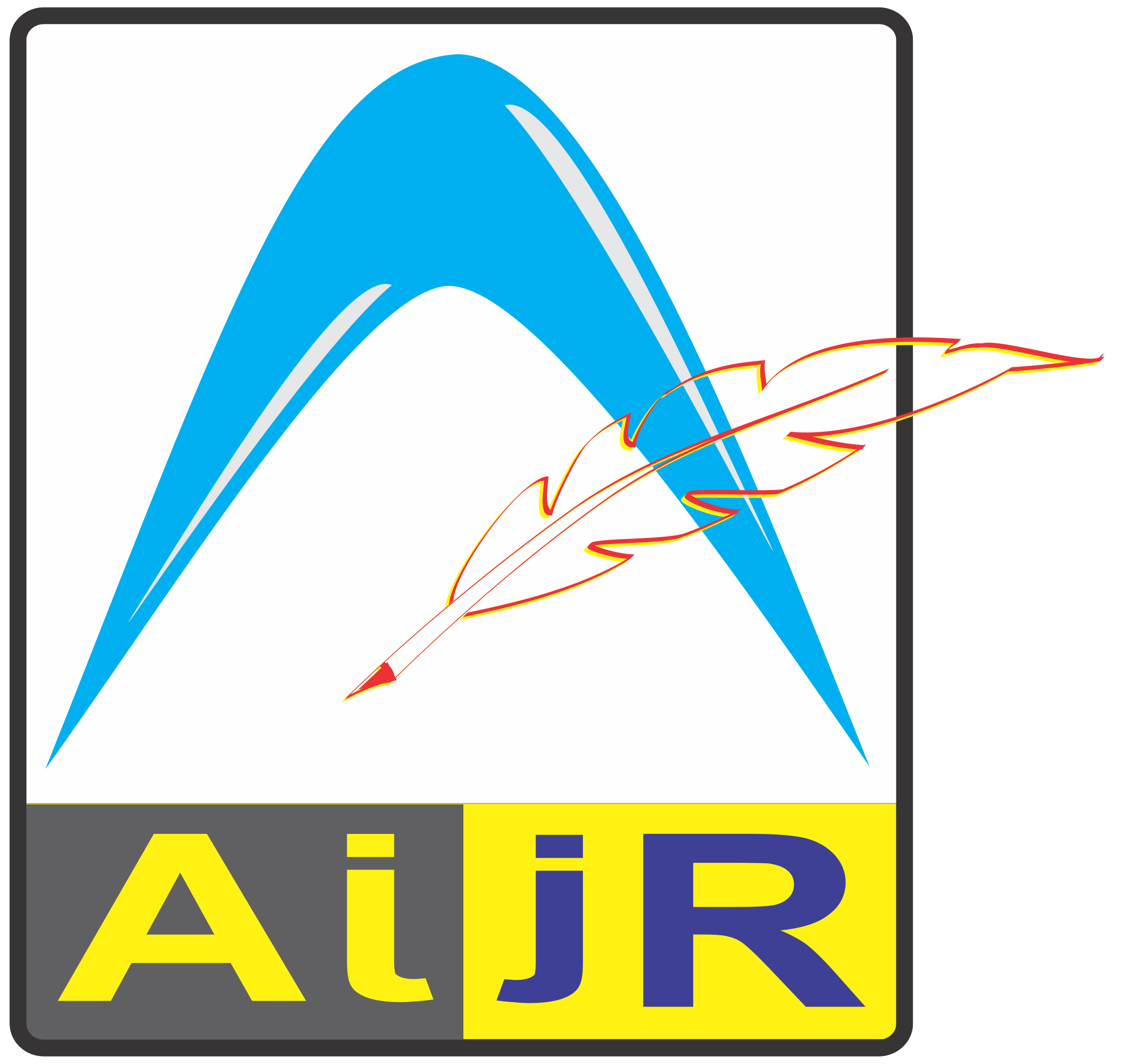
Free Paper Publication
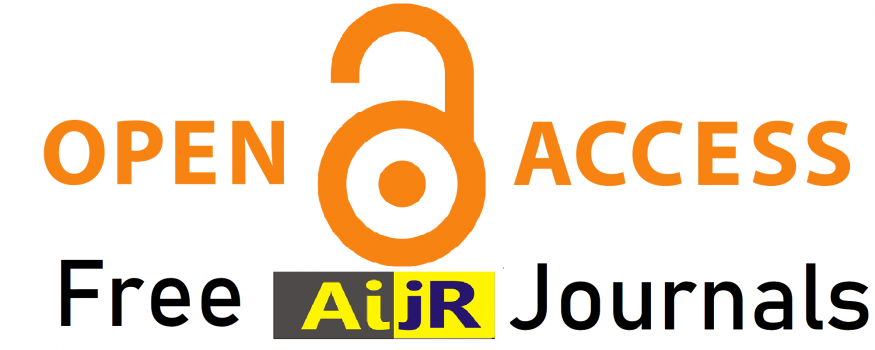
AIJR offers Free Paper Publication in the following international refereed journals with open access ( Free to Publish & Free to Read ) – No hidden charges
- Journal of Modern Materials (Materials Science Journal)
- Journal of Modeling and Simulation of Materials (Modeling & Simulation Journal)
- Advanced Journal of Graduate Research (Bachelor / Master Degree Student’s Research Paper)
- Advanced Nano Research (Nano Research Journal)
- Extensive Reviews (Review Articles from All Discipline)
- International Journal of Methodology (Articles Discussing Research Method
Besides free paper publication (Normal Publication), the above journals are also offering various rapid review options through fast-track publication which is optional. The author needs to send an additional email request to consider articles under the fast track for rapid publication. All submitted paper to journals published by AIJR undergoes rigorous peer review and upon acceptance made available free for everyone to read and download as per end user license .
Authors are requested to read the author guidelines of the corresponding journal and follow them precisely to prepare the research paper. Author guideline is available at the homepage of each journal. The author will require to provide all information for each author in the manuscript and all author(s) specified in the manuscript must be added during online submission in step 3 with proper order and complete detail . Reference citation and reference list should be followed as specified in the author guideline of the journal. All relevant information regarding the journal is available in the About section of the journal at their homepage.
Manuscript submissions for possible publication to jour n als are invited from the worldwide research community. The manuscript should be original and formatted as per the author’s guidelines. All manuscripts should be submitted with all required detail.

Free Journals with Open Access Publication

Publish Conference Proceedings

Call for Papers on Chemical Sciences

Publish Review Article

Coronavirus Variants Greek Alphabet Naming Scheme by WHO

Call for Papers: Nanoscience and Nanotechnology
- Publish with AIJR
- Journal Word Template
- Paper Publishing Process
- Editorial Screening Process
- Ethics for Authors
- Guest Posting Blog
- Submit Proceedings Proposal
- Submit Abstract Book Proposal
- Submit Conference Issue Proposal
- Proceedings vs Book of Abstracts
- Proceedings vs Special Issue
Privacy Overview


Libraries’ Read and Publish Agreement With Springer Allows Easier Open Access for Researchers
Syracuse University Libraries recently signed its 12th ‘read and publish’ open access agreement, this time with major academic publisher Springer , expanding the reach of researchers’ scholarly contributions by enabling all University-affiliated authors the ability to publish their work open access in Springer’s more than 2,000 hybrid journals at no charge to them.

Syracuse University Libraries recently signed a ‘read and publish’ open access agreement with major academic publisher Springer to expand the reach of researchers’ scholarly contributions.
Open access allows anyone to use these scholarly works, free of charge and free of most copyright and licensing restrictions for further use. ‘Read and publish’ agreements allow University-affiliated authors to make their work immediately open access when they run in journals that are published by these organizations, at no cost to the author.
Springer journals constitute one of the largest publication venues for Syracuse University’s authors. Based on the strong publication history of University authors in Springer titles, Syracuse University Libraries expect this most recent three-year agreement to have a wide reach. Springer imprints covered by this agreement include Palgrave Macmillan journals, Adis Journals and academic journals. Excluded are gold open-access titles and nature-branded journal titles.
“This is a substantive agreement that the Libraries is supporting, and we believe it will have broad impact for our University-affiliated authors,” says David Seaman , dean of the Libraries and University Librarian. “Increasing the opportunities for open access publishing at no cost to the authors is an important goal in the Libraries’ academic strategic plan. We are committed to driving the open distribution of research data and scholarship to increase the University’s global impact and reputation.”
This agreement was negotiated through the NorthEAST Research Libraries consortium (NERL) for seven NERL member institutions. Scott Warren, the Libraries’ senior associate dean for research excellence, co-chaired the NERL negotiation team. More information on the NERL and Springer open publishing agreement is available on the Center for Research Libraries’ website .
For more information, including instructions on how authors can take advantage of these agreements, visit the Transformative Agreements and APC Coverage Research Guide .
Cristina Hatem
- Faculty and Staff: Join Your Colleagues at the Syracuse WorkForce Run/Walk/Roll for Food, Fitness and Fun Friday, April 19, 2024, By News Staff
- Behind the Scenes Heroes: The Impactful Role of Public Safety Dispatchers Friday, April 19, 2024, By Alex Haessig
- ‘The Droll (Or, a Stage-Play about the END of Theatre)’ Closes Out Department of Drama 2023-24 Season Thursday, April 18, 2024, By Joanna Penalva
- Auxiliary Services Welcomes New Executive Chef for Campus Dining Thursday, April 18, 2024, By Abby Haessig
- Campus Dining and Stores to Become Fully Cashless in Fall 2024 Thursday, April 18, 2024, By Abby Haessig
More In Campus & Community
Faculty and staff: join your colleagues at the syracuse workforce run/walk/roll for food, fitness and fun.
At the 2023 Syracuse WorkForce Run/Walk/Roll (formerly the J.P. Morgan Corporate Challenge), Syracuse University held the distinction of being the largest employer represented among dozens of local companies participating in the annual tradition for the second year in a row….
5 Honorary Degrees to Be Presented at 2024 Commencement
An award-winning journalist, a hall of fame basketball coach, a nationally recognized library conservationist, a global financial executive and a renowned computer scientist will be recognized with honorary degrees from Syracuse University at the 2024 Commencement on Sunday, May 12,…
Behind the Scenes Heroes: The Impactful Role of Public Safety Dispatchers
Every year, the second week of April marks National Public Safety Telecommunicators Week (NPSTW), a time dedicated to recognizing and celebrating the dedication, service and sacrifices of public safety telecommunicators. The staff of the Emergency Communications Center (ECC) within the…
Libraries’ Earth Day Events Highlight Plastic Collection Materials
Plastics. They’re lightweight, durable, flexible, inexpensive. They’re moldable, extrudable, pressable. They’re colored and clear; they’re dinnerware, jewelry, vinyl siding, military supplies, toys and thousands more things. In the early half of the 20th century, the availability of polymers and fossil…
Auxiliary Services Welcomes New Executive Chef for Campus Dining
A Syracuse native, Chef Ilana (Ih-lah-nah) Cahill’s culinary journey began at one of the city’s most iconic restaurants: Dinosaur BBQ. She spent nine years there, starting out as the hostess and working her way up through the ranks. When Cahill…
Subscribe to SU Today
If you need help with your subscription, contact [email protected] .
Connect With Us
For the media.
Maintenance work is planned for Wednesday 1st May 2024 from 9:00am to 11:00am (BST).
During this time, the performance of our website may be affected - searches may run slowly and some pages may be temporarily unavailable. If this happens, please try refreshing your web browser or try waiting two to three minutes before trying again.
We apologise for any inconvenience this might cause and thank you for your patience.
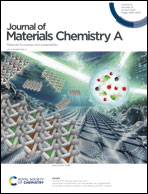
Journal of Materials Chemistry A
Zn alloying strategy to improve the photoluminescence of cugas 2 /zns core/shell quantum dots †.

* Corresponding authors
a Department of Physics, Savitribai Phule Pune University, Pune 411 007, India E-mail: [email protected]
b Symbiosis Center for Nanoscience and Nanotechnology, Symbiosis International University, Lavale, Pune 412 115, India
c Atomic & Molecular Physics Division, Bhabha Atomic Research Centre, Mumbai 400 094, India
d Beamline Development and Application Section, Bhabha Atomic Research Centre, Mumbai 400 094, India
Research efforts are being devoted to realize colloidal, heavy metal ion free, and luminescent quantum dots. We address radiative recombination in Zn alloyed CuGaS 2 /ZnS core/shell chalcopyrite quantum dots (CQDs) emitting in the blue-green spectral region. QDs show a systematic increase in the optical band gap and emission energy with an increasing amount of Zn in their core. Intentionally making non-stoichiometric CQDs with core/shell geometry enables defect related emission with high intensity. The location of Cu related defect levels along with the valence band and conduction band edge was determined from electrochemical cyclic voltammetry (CV) measurements. The evolution of band gap energies with respect to Zn concentration examined using CV measurements matches well with the optical absorption data. The presence of Cu vacancies in off-stoichiometric samples introduces intra-gap levels, which serve as common acceptor levels for optical transitions. Luminescence transitions in these materials stem from the radiative recombination of electrons from conduction levels as well as donor levels, with holes localized at acceptor levels. Temperature dependent and excitation laser intensity dependent emission measurements confirm the role of the Cu vacancy related acceptor level in the emission. Local structure studies via extended X-ray absorption fine structure and X-ray absorption near edge structure analysis were carried out to understand how Zn is incorporated in CuGaS 2 quantum dots and affects the luminescence. Electron spin resonance measurements confirm the presence of paramagnetic defect complexes. X-ray absorption near edge structure measurements indicate that Cu co-exists in +1 and +2 oxidation states in CuGaS 2 quantum dots.
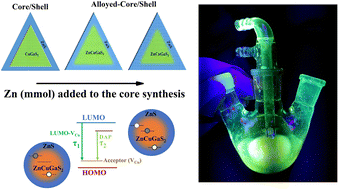
- This article is part of the themed collection: Journal of Materials Chemistry A HOT Papers
Supplementary files
- Supplementary information PDF (729K)
Article information
Download citation, permissions.
Zn alloying strategy to improve the photoluminescence of CuGaS 2 /ZnS core/shell quantum dots
M. A. Haque, A. Lohar, Y. Jadhav, R. Kumar, S. N. Jha, D. Bhattacharyya, S. Jadkar, S. Sartale and S. Mahamuni, J. Mater. Chem. A , 2024, Advance Article , DOI: 10.1039/D4TA01134A
To request permission to reproduce material from this article, please go to the Copyright Clearance Center request page .
If you are an author contributing to an RSC publication, you do not need to request permission provided correct acknowledgement is given.
If you are the author of this article, you do not need to request permission to reproduce figures and diagrams provided correct acknowledgement is given. If you want to reproduce the whole article in a third-party publication (excluding your thesis/dissertation for which permission is not required) please go to the Copyright Clearance Center request page .
Read more about how to correctly acknowledge RSC content .
Social activity
Search articles by author.
This article has not yet been cited.
Advertisements
- Skip to main content
- Keyboard shortcuts for audio player
Coral reefs can't keep up with climate change. So scientists are speeding up evolution

Lauren Sommer

Ryan Kellman
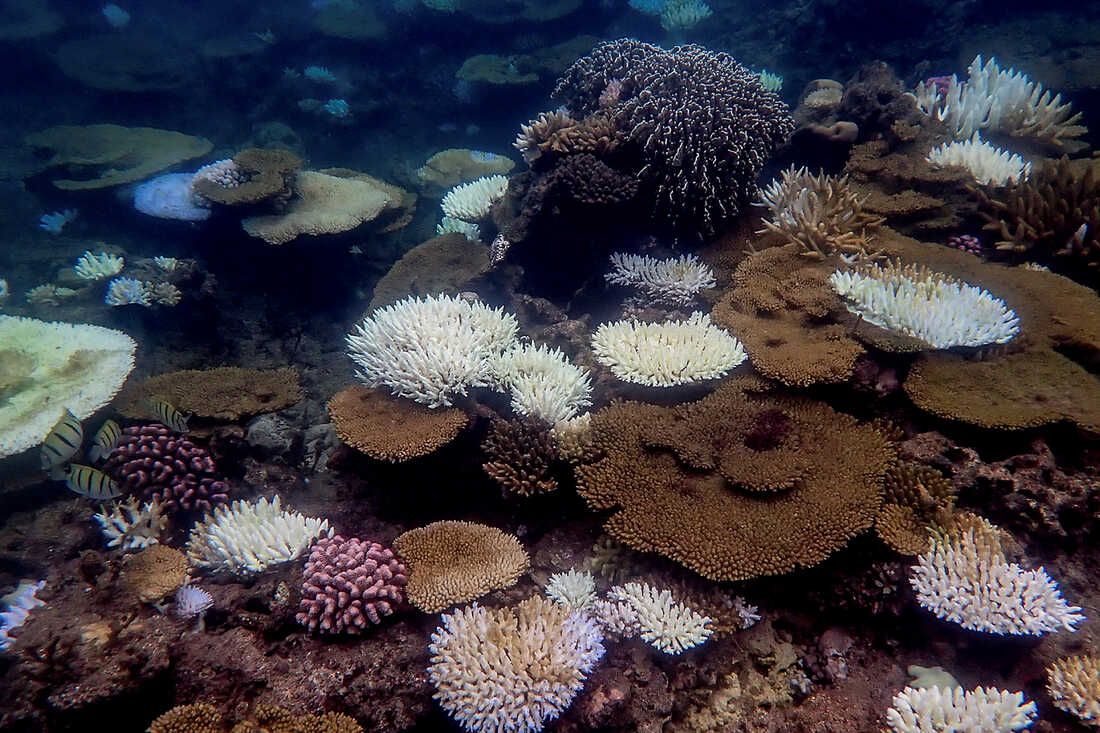
Record levels of heat in the ocean are causing a worldwide mass bleaching event on coral reefs, as seen here on the Great Barrier Reef. Scientists are working on creating more heat-resistant coral to help restore reefs. Veronique Mocellin /AIMS hide caption
Record levels of heat in the ocean are causing a worldwide mass bleaching event on coral reefs. It's the second one this decade, where the delicate skeletons of corals turn a ghostly white.
With mass bleaching only expected to get worse as the climate keeps warming, coral scientists are urgently searching for ways to help reefs endure. Bleaching can kill corals, putting some of the most diverse ecosystems in the world at risk. So scientists are homing in on how bleaching happens.
It boils down to relationship drama between corals and a tiny organism that's too small to see.

Scientists estimate that a quarter of all marine species depend on coral reefs. Biologists say that's a best guess and it's very likely there are species yet to be discovered. Ryan Kellman/NPR hide caption
Corals are the builders of reefs, their skeletons creating the vast infrastructure that tens of thousands of other species depend on. But corals are powered by the tiny algae that live in their tissue, which provide food for them.
"They're these microscopic, sort of nondescript algae," says Matthew Nitschke, research scientist at the Australian Institute of Marine Science, as he magnifies a few under a microscope, revealing golden-brown circles.

Scientists are breeding 'super corals.' Can they withstand climate change?
"People are like: why are you so interested in them?" he says. "And it's because they, for me, are really at the foundation of the ecosystem."
The tiny algae and coral make up one of the most productive roommate relationships on the planet. But as the climate gets hotter, that relationship is increasingly going bad. When ocean temperatures rise, corals get stressed and their algae get expelled. Without their roommates, corals can starve and eventually die.
Studies show that if climate change continues at the same pace, 99% of the world's coral reefs are likely to die off by the end of the century. To buy reefs a little extra time, scientists are breeding both algae and corals to withstand more heat, speeding up the natural process of evolution. But with oceans heating up more rapidly than expected, they're racing against the clock.
"I think anyone who wasn't worried, needs to be worried now," says Kate Quigley, coral biologist at James Cook University in Australia and the Minderoo Foundation. "Nature has time to make mistakes and then adjust. We don't have that time."

"There just doesn't seem be enough time," says Kate Quigley, coral biologist at James Cook University in Australia and the Minderoo Foundation. "We're going from one bleaching event to the next." Ryan Kellman/NPR hide caption
Natural selection in a bottle
The tanks at the Australian Institute of Marine Science, just outside of Townsville in Queensland, are full of delicate branching corals in a vast array of colors. Another lab there is somewhat less eye-catching – full of scientific flasks with clouds of brown algae in them. They're zooxanthellae, the algae that live in coral, but these have been isolated from their coral homes (the algae can live in the ocean without the coral, but coral can't live without algae).
"If you look at a coral, they look bright, they look colorful," Nitschke says. "They're actually mostly translucent and a lot of the color of the coral that you see comes from the algae."
The algae in Nitschke's lab have been grown over hundreds of generations, subjected to an accelerated version of survival-of-the-fittest. They've been exposed to heat, singling out those best able to handle higher temperatures, which then go to produce future algal generations.
"What we're really doing is natural selection in a bottle," he says. "We're really excited about the possibility for that to help corals persist into the future."

Algae in Nitschke's lab, grown over hundreds of generations. They've been exposed to heat, singling out those best able to handle higher temperatures, which then go to produce more heat-tolerant algae. Ryan Kellman/NPR hide caption
Scientists are still trying to tease out exactly what happens between a coral and its algae when temperatures get hot. They depend on a carefully-balanced living arrangement. The algae get a comfy home and nutrients they need from the coral. In return, they do photosynthesis, using sunlight to produce energy for the coral.
But when the ocean heats up, that balance gets upset. Scientists believe one reason is that the warmer water stresses the coral, upsetting the nutrient exchange between the coral and algae. Another reason could be that the hotter water impairs how cells function, causing them to release too much of certain chemicals. The result is that most algae get the boot, leaving the coral without its main food supply.
"They begin to starve," Nitschke says. "That primary energy source – the loss of that during a heat stress event is potentially catastrophic for an individual coral. They are now in a race against time."

Corals bleach, turning ghostly white, when they're under stress from hotter temperatures. If the heat subsides, they can recover. But long periods of heat and repeated marine heat waves cause corals to die, wreaking havoc on one of the most biodiverse ecosystems on the planet. Veronique Mocellin /AIMS hide caption
Buying time for coral
If the heat subsides, corals can recover, slowly building back their algae population. But if the heat persists, or if there are too many marine heat waves back-to-back, the corals die.
Bleaching events are becoming more frequent, putting corals on a path for a mass die-off by the end of the century if the planet warms more than 2 degrees Celsius (3.6 degrees Fahrenheit). The effects could be devastating for marine biodiversity and for human communities. Hundreds of millions of people worldwide live near coral reefs, relying on them for food and coastal protection, since reefs can reduce flooding by absorbing wave energy.
It's why Nitschke and his colleagues have focused on breeding algae. They're in the process of testing them, giving them to tiny brain corals the size of walnuts. In trials, they've found corals inoculated with the heat-tolerant algae seem to resist bleaching for longer .

Corals the size of walnuts have been inoculated with heat resistant algae by Matthew Nitschke and his colleagues at the Australian Institute of Marine Science. They've found corals inoculated with heat-tolerant algae seem to resist bleaching for longer. Ryan Kellman/NPR hide caption
Researchers are also breeding corals themselves to be more heat-tolerant, in the hope that a combination of both a "super coral" and "super algae" can be used to restore reefs someday. Both are "assisted evolution" – a technique to speed up the natural process organisms use to adapt to their environment.
"Assisted evolution is an umbrella term for many things we've been doing in many other systems: agriculture, for pets." Nitschke says. "We're really only just starting to understand what we can do in the coral space."

Research aquarist Andrea Severati peers at large sheets over which coral larvae were released to settle. Once corals have picked their spot, each will be assessed for coral growth and survival. Ryan Kellman/NPR hide caption
Not a "get out of jail free" card
Still, in nature, there is no free lunch. Heat-tolerant algae may not share as many nutrients with their coral hosts, which means corals grow more slowly and reproduce later than they would otherwise. That could hamper their ability to restore reefs impacted by climate change. A key step will be testing the corals and algae on the Great Barrier Reef itself to see how they do.
"The last thing we want to do is make things worse," says Line Bay, a research program director at the Australian Institute of Marine Science. "We don't want to produce lab-adapted corals and then put them out in the real world where they don't do well."
Even if the heat-tolerant corals prove to be successful, the number of coral needed to restore impaired reefs could be enormous. The Great Barrier Reef is more than 1,000 miles long. And regulators will need to assess if the corals pose any risk to wild populations or the ecosystem as a whole.
The corals developed at AIMS are placed by divers on the Great Barrier reef. They are being tested in the ocean, as part of a large field trial.
Credit: AIMS
"Coral reefs are magical places," Bay says. "I think we need to be brave and we should use all the tools at our disposal in a humble and sensitive manner."
Coral scientists are clear about one aspect of the work: it's not a long-term solution. At best, it only buys coral reefs extra time until the effects of climate change become too much.
"It's not our 'get out of jail free' card," Quigley says. "Maybe that gets us to 2030, 2050 for a very few number of species that we can work with. If we don't have an ocean to put them back in that's healthy, no amount of incredible technology or money is worth it."
The hope is that giving coral reefs a few extra years, or even decades, will be enough time for humans to slow the pace of climate change. That means cutting heat-trapping emissions from the largest source – burning fossil fuels – and switching to alternative energy sources like solar and wind.
"We could all be despondent and be hopeless if there weren't great solutions on the table to turn climate change problems around," Quigley says. "We just need to get it on, now, really."
- coral reefs
- Great Barrier Reef
- conservation
- climate change
Numbers, Facts and Trends Shaping Your World
Read our research on:
Full Topic List
Regions & Countries
- Publications
- Our Methods
- Short Reads
- Tools & Resources
Read Our Research On:
What we know about unauthorized immigrants living in the U.S.
The unauthorized immigrant population in the United States reached 10.5 million in 2021, according to new Pew Research Center estimates. That was a modest increase over 2019 but nearly identical to 2017.
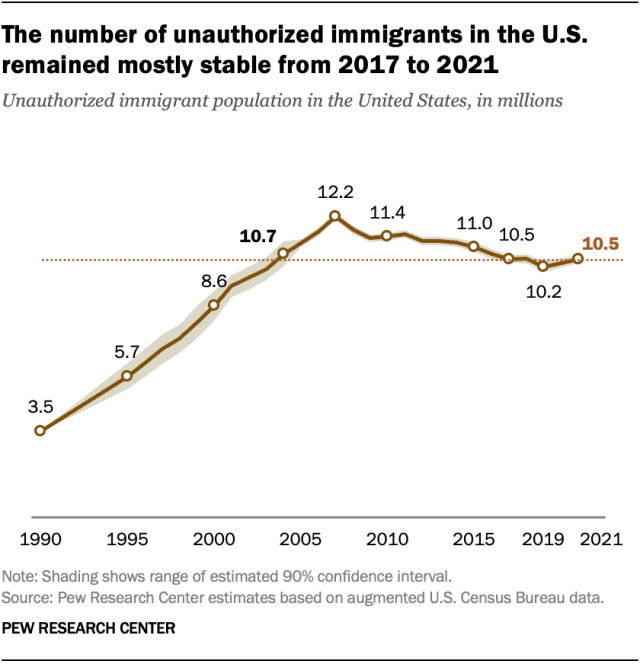
The number of unauthorized immigrants living in the U.S. in 2021 remained below its peak of 12.2 million in 2007. It was about the same size as in 2004 and lower than every year from 2005 to 2015.
The new estimates do not reflect changes that have occurred since apprehensions and expulsions of migrants along the U.S.-Mexico border started increasing in March 2021 . Migrant encounters at the border have since reached historic highs .
Pew Research Center undertook this research to understand ongoing changes in the size and characteristics of the unauthorized immigrant population in the United States. The Center has published estimates of the U.S. unauthorized immigrant population for more than two decades. The estimates presented in this research are the Center’s latest, adding new and updated annual estimates for 2017 through 2021.
Center estimates of the unauthorized immigrant population use a “residual method.” It is similar to methods used by the U.S. Department of Homeland Security’s Office of Immigration Statistics and nongovernmental organizations, including the Center for Migration Studies and the Migration Policy Institute . Those organizations’ estimates are generally consistent with ours. Our estimates also align with official U.S. data sources, including birth records, school enrollment figures and tax data, as well as Mexican censuses and surveys.
Our “residual” method for estimating the nation’s unauthorized immigrant population includes these steps:
- Estimate the total number of immigrants living in the country in a particular year using data from U.S. censuses and government surveys such as the American Community Survey and the Current Population Survey.
- Estimate the number of immigrants living in the U.S. legally using official counts of immigrant and refugee admissions together with other demographic data (for example, death and out-migration rates).
- Subtract our estimate of lawful immigrants from our estimate of the total immigrant population . This provides an initial estimate of the unauthorized immigrant population .
Our final estimate of the U.S. unauthorized immigrant population, as well as estimates for lawful immigrants, includes an upward adjustment. We do this because censuses and surveys tend to miss some people . Undercounts for immigrants, especially unauthorized immigrants, tend to be higher than for other groups. (Our 1990 estimate comes from work by Robert Warren and John Robert Warren; details can be found here .)
The term “unauthorized immigrant” reflects standard and customary usage by many academic researchers and policy analysts. The U.S. Department of Homeland Security’s Office of Immigration Statistics also generally uses it. The term means the same thing as undocumented immigrants, illegal immigrants and illegal aliens.
For more details on how we produced our estimates, read the Methodology section of our November 2018 report on unauthorized immigrants.
The unauthorized immigrant population includes any immigrants not in the following groups:
- Immigrants admitted for lawful residence (i.e., green card admissions)
- People admitted formally as refugees
- People granted asylum
- Former unauthorized immigrants granted legal residence under the 1985 Immigration Reform and Control Act
- Immigrants admitted under any of categories 1-4 who have become naturalized U.S. citizens
- Individuals admitted as lawful temporary residents under specific visa categories
Read the Methodology section of our November 2018 report on unauthorized immigrants for more details.
Pew Research Center’s estimate of unauthorized immigrants includes more than 2 million immigrants who have temporary permission to be in the United States. (Some also have permission to work in the country.) These immigrants account for about 20% of our national estimate of 10.5 million unauthorized immigrants for 2021.
Although these immigrants have permission to be in the country, they could be subject to deportation if government policy changes. Other organizations and the federal government also include these immigrants in their estimates of the U.S. unauthorized immigrant population.
Immigrants can receive temporary permission to be in the U.S. through the following ways:
Temporary Protected Status (TPS)
In 2021, there were about 500,000 unauthorized immigrants with Temporary Protected Status . This status provides protection from removal or deportation to individuals who cannot safely return to their country because of civil unrest, violence or natural disaster.
Deferred Enforced Departure (DED) is a similar program that grants protection from removal. The number of immigrants with DED is much smaller than the number with TPS.
Deferred Action for Childhood Arrivals (DACA)
Deferred Action for Childhood Arrivals is a program that offers protection from deportation to individuals who were brought to the U.S. as children before June 15, 2007. As of the end of 2021, there were slightly more than 600,000 DACA beneficiaries , largely immigrants from Mexico.
Asylum applicants
Individuals who have applied for asylum but are awaiting a ruling are not legal residents yet but cannot be deported. There are two types of asylum claims, defensive and affirmative .
Defensive asylum applications are generally filed by individuals facing deportation or removal from the U.S. These are processed by the Department of Justice’s Executive Office for Immigration Review. At the end of 2021, there were almost 600,000 applications pending.
Affirmative asylum claims are made by individuals already in the U.S. who are not in the process of being deported or removed. These claims are handled by the U.S. Department of Homeland Security’s Citizenship and Immigration Services (USCIS). At the end of 2021, more than 400,000 applications for affirmative asylum were pending, some covering more than one applicant.
Here are key findings about how the U.S. unauthorized immigrant population changed from 2017 to 2021:
- The most common country of birth for unauthorized immigrants is Mexico. However, the population of unauthorized immigrants from Mexico dropped by 900,000 from 2017 to 2021 , to 4.1 million.
- There were increases in unauthorized immigrants from nearly every other region of the world – Central America, the Caribbean, South America, Asia, Europe and sub-Saharan Africa.
- Among U.S. states, only Florida and Washington saw increases to their unauthorized immigrant populations , while California and Nevada saw decreases. In all other states, unauthorized immigrant populations were unchanged.
- 4.6% of U.S. workers in 2021 were unauthorized immigrants , virtually identical to the share in 2017.
Trends in the U.S. immigrant population
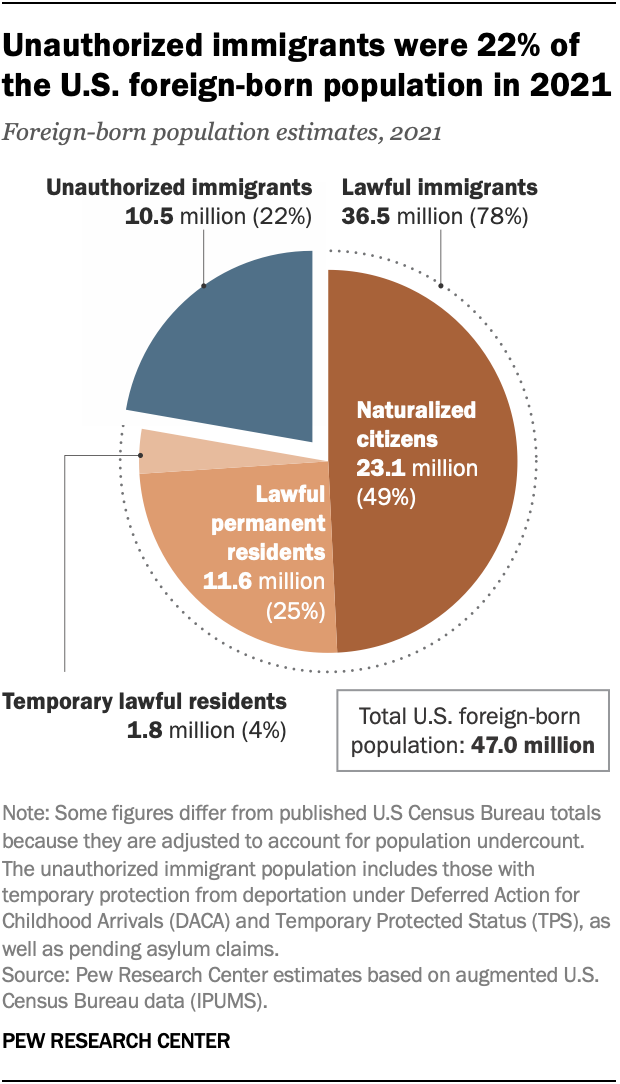
The U.S. foreign-born population was 14.1% of the nation’s population in 2021. That was very slightly higher than in the last five years but below the record high of 14.8% in 1890.
As of 2021, the nation’s 10.5 million unauthorized immigrants represented about 3% of the total U.S. population and 22% of the foreign-born population. These shares were among the lowest since the 1990s.
Between 2007 and 2021, the unauthorized immigrant population decreased by 1.75 million, or 14%.
Meanwhile, the lawful immigrant population grew by more than 8 million, a 29% increase, and the number of naturalized U.S. citizens grew by 49%. In 2021, naturalized citizens accounted for about half (49%) of all immigrants in the country.
Where unauthorized immigrants come from
Unauthorized immigrants living in the U.S. come from many parts of the world, with Mexico being the most common origin country.
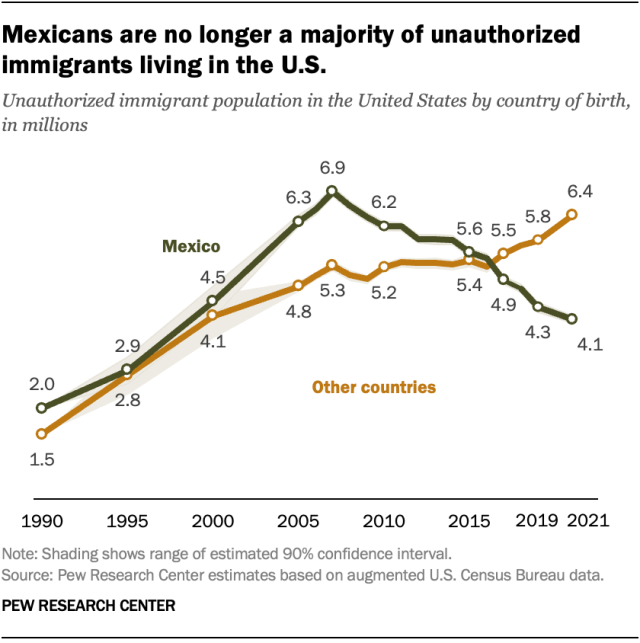
The origin countries for unauthorized immigrants have changed since the population peaked in 2007, before the Great Recession slowed immigration. Here are some highlights of those changes:
The number of unauthorized immigrants from Mexico living in the U.S. (4.1 million in 2021) was the lowest since the 1990s. Mexico accounted for 39% of the nation’s unauthorized immigrants in 2021, by far the smallest share on record .
The decrease in unauthorized immigrants from Mexico reflects several factors:
- A broader decline in migration from Mexico to the U.S.
- Mexican immigrants to the U.S. continuing to return to Mexico
- Expanded opportunities for lawful immigration from Mexico and other countries, especially for temporary agricultural workers.
The rest of the world
The total number of unauthorized immigrants in the U.S. from countries other than Mexico has grown rapidly. In 2021, this population was 6.4 million, up by 900,000 from 2017.
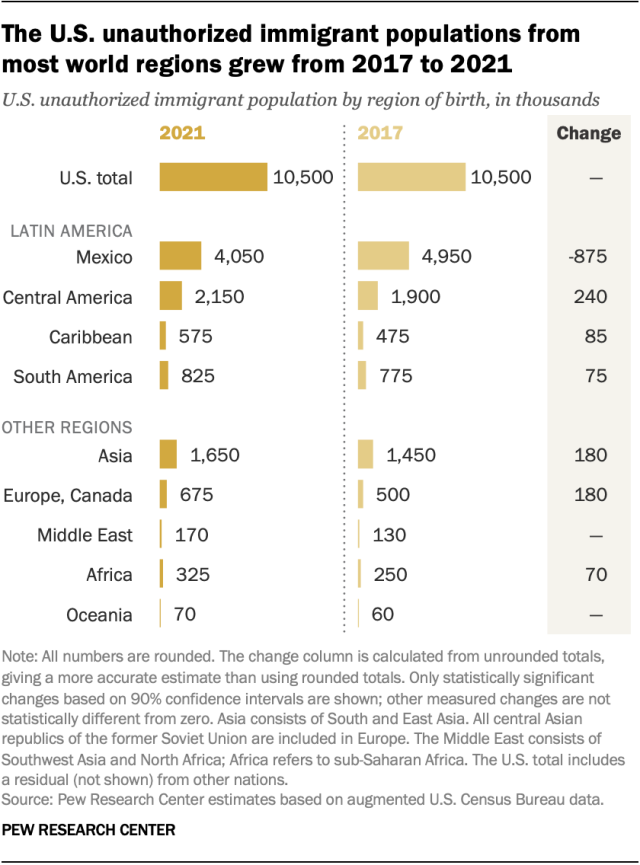
Almost every region in the world had a notable increase in the number of unauthorized immigrants in the U.S. from 2007 to 2021. The largest increases were from Central America (240,000) and South and East Asia (180,000).
After Mexico, the countries of origin with the largest unauthorized immigrant populations in the U.S. in 2021 were:
- El Salvador (800,000)
- India (725,000)
- Guatemala (700,000)
- Honduras (525,000)
India, Guatemala and Honduras all saw increases from 2017.
The Northern Triangle
Three Central American countries – El Salvador, Honduras and Guatemala – together represented 2.0 million unauthorized immigrants in the U.S. in 2021, or almost 20% of the total. The unauthorized immigrant population from the Northern Triangle grew by about 250,000 from 2017 and about 700,000 from 2007.
Other origin countries
Venezuela was the country of birth for 190,000 U.S. unauthorized immigrants in 2021. This population saw particularly fast growth, from 130,000 in 2017 and 55,000 in 2007.
Among countries with the largest numbers of U.S. unauthorized immigrants, India, Brazil, Canada and former Soviet Union countries all experienced growth from 2017 to 2021.
Some origin countries with significant unauthorized immigrant populations showed no change, notably China (375,000) and the Dominican Republic (230,000).
Detailed table: Unauthorized immigrant population by region and selected country of birth (and margins of error), 1990-2021 (Excel)
U.S. states of residence of unauthorized immigrants
The unauthorized immigrant population in most U.S. states stayed steady from 2017 to 2021. However, four states saw significant changes:
- Florida (+80,000)
- Washington (+60,000)
- California (-150,000)
- Nevada (-25,000)
States with the most unauthorized immigrants
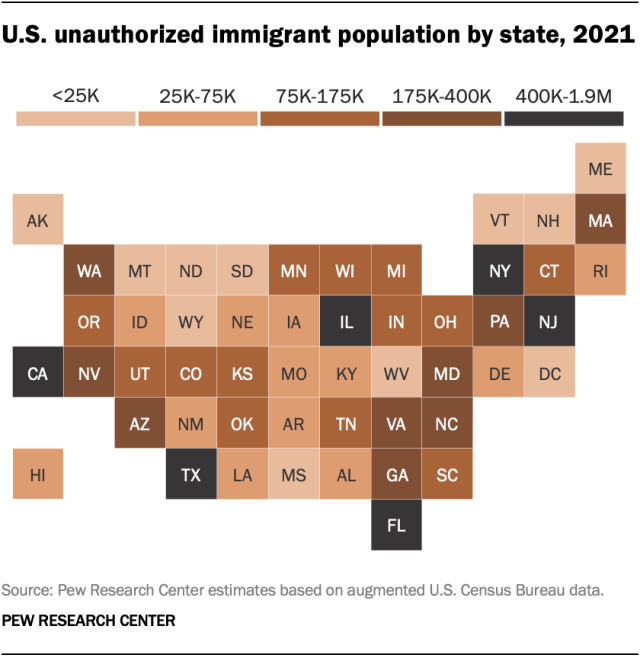
The six states with the largest unauthorized immigrant populations in 2021 were:
- California (1.9 million)
- Texas (1.6 million)
- Florida (900,000)
- New York (600,000)
- New Jersey (450,000)
- Illinois (400,000)
These states have consistently had the most unauthorized immigrants since 1990 and earlier .
At the same time, the unauthorized immigrant population has become less geographically concentrated. In 2021, these six states were home to 56% of the nation’s unauthorized immigrants, down from 80% in 1990.
Detailed table: Unauthorized immigrant population for states (and margins of error), 1990-2021 (Excel)
Detailed table: Unauthorized immigrants and characteristics for states, 2021 (Excel)
Unauthorized immigrants in the labor force
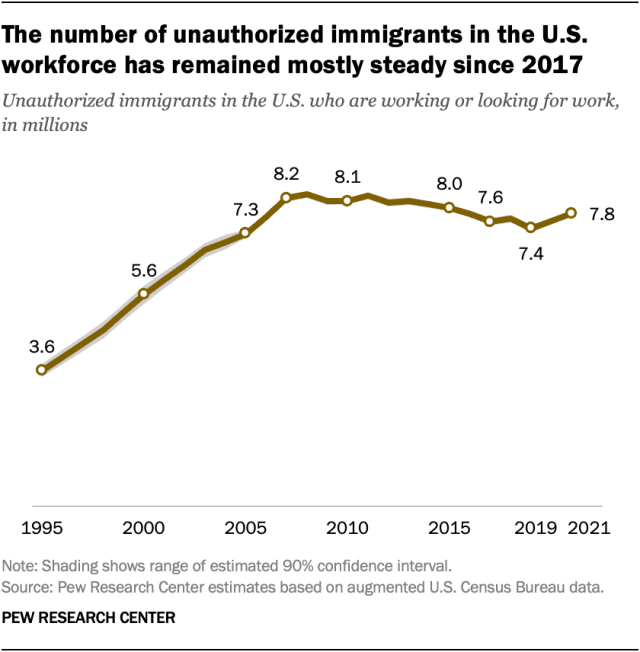
The share of unauthorized immigrants in the U.S. workforce was slightly less than 5% in 2021, compared with 3% of the total U.S. population.
Demographics help explain the difference: The unauthorized immigrant population includes relatively few children or elderly adults, groups that tend not to be in the labor force.
Overall, about 7.8 million unauthorized immigrants were in the U.S. labor force in 2021. That was up slightly from 2019 but smaller than every year from 2007 through 2015.
Detailed table: Unauthorized immigrants in the labor force for states, 2021 (Excel)
Here are some additional findings about unauthorized immigrants as a share of the workforce nationwide and in certain states:
- Since 2003, unauthorized immigrants have made up 4.4% to 5.4% of all U.S. workers, a relatively narrow range.
- Fewer than 1% of workers in Maine, Montana, Vermont and West Virginia in 2021 were unauthorized immigrants.
- Nevada (9%) and Texas (8%) had the highest shares of unauthorized immigrants in the workforce.
- Immigrant Populations
- Immigration Issues
- Unauthorized Immigration
Key facts about Asian Americans living in poverty
Latinos’ views on the migrant situation at the u.s.-mexico border, key facts about the nation’s 47.9 million black americans, key facts about the wealth of immigrant households during the covid-19 pandemic, 8 facts about recent latino immigrants to the u.s., most popular.
1615 L St. NW, Suite 800 Washington, DC 20036 USA (+1) 202-419-4300 | Main (+1) 202-857-8562 | Fax (+1) 202-419-4372 | Media Inquiries
Research Topics
- Age & Generations
- Coronavirus (COVID-19)
- Economy & Work
- Family & Relationships
- Gender & LGBTQ
- Immigration & Migration
- International Affairs
- Internet & Technology
- Methodological Research
- News Habits & Media
- Non-U.S. Governments
- Other Topics
- Politics & Policy
- Race & Ethnicity
- Email Newsletters
ABOUT PEW RESEARCH CENTER Pew Research Center is a nonpartisan fact tank that informs the public about the issues, attitudes and trends shaping the world. It conducts public opinion polling, demographic research, media content analysis and other empirical social science research. Pew Research Center does not take policy positions. It is a subsidiary of The Pew Charitable Trusts .
Copyright 2024 Pew Research Center
Terms & Conditions
Privacy Policy
Cookie Settings
Reprints, Permissions & Use Policy

COMMENTS
How to Publish a Research Paper for Free. Publishing a research paper for free can be challenging, but it is possible. Here are some steps you can take to publish your research paper for free: Choose a suitable open-access journal: Look for open-access journals that are relevant to your research area. Open-access journals allow readers to ...
ResearchGate. ResearchGate is a platform hosting over 135 million publication pages with a community of 20 million scientists. The platform allows you to show off your work, access papers and advice from other researchers, make contacts and even find jobs. Some of its more prominent features include: Dedicated Q&A section with searchable ...
Every year, we accept and publish more than 470,000 journal articles so you are in safe hands. Publishing in an Elsevier journal starts with finding the right journal for your paper. We have tools, resources and services to help you at each stage of the publication journey to enable you to research, write, publish, promote and track your article.
Many free-to-publish and open-access journals and subscription journals from major publishers are "Free to author" by default. Some journals require an article processing charge (APC) but also have a policy allowing them to waive fees on request at the discretion of the editor. The Directory of Open Access Journals currently indexes 11,841 ...
3. Submit your article according to the journal's submission guidelines. Go to the "author's guide" (or similar) on the journal's website to review its submission requirements. Once you are satisfied that your paper meets all of the guidelines, submit the paper through the appropriate channels.
How we publish. All Frontiers journals are community-run and fully open access, so every research article we publish is immediately and permanently free to read. Editor guidelines. ... Here are just five amazing papers you may have missed. RESEARCH TOPICS.
Step 5: Submitting Your Paper. As we've already pointed out, one of the key elements in how to publish a research paper is ensuring that you meticulously follow the journal's submission guidelines. Strive to comply with all formatting requirements, including citation styles, font, margins, and reference structure.
Publishing your article open access has a number of benefits: Free to access and download; Reaches a wider global audience; 1.6x more citations; 6x more downloads; 4.9 average Altmetric attention (vs 2.1 subscription) It's free to publish your article in a subscription journal, but there are fees for publishing open access articles.
Production. - Copy editing and language polishing. - Data processing and type setting. - Article Tracking. - Checking your article: proofing procedure. - e.Proofing - Makes editing easy! Read more. Publication. - Publishing your article "Online First".
Communicating research findings is an essential step in the research process. Often, peer-reviewed journals are the forum for such communication, yet many researchers are never taught how to write a publishable scientific paper. In this article, we explain the basic structure of a scientific paper and describe the information that should be included in each section. We also identify common ...
Access 160+ million publications and connect with 25+ million researchers. Join for free and gain visibility by uploading your research.
Step 1: Choosing a journal. Choosing which journal to publish your research paper in is one of the most significant decisions you have to make as a researcher. Where you decide to submit your work can make a big difference to the reach and impact your research has. It's important to take your time to consider your options carefully and ...
This post will discuss 7 steps to the successful publication of your research paper: Check whether your research is publication-ready. Choose an article type. Choose a journal. Construct your paper. Decide the order of authors. Check and double-check. Submit your paper. 1.
Choose a research paper topic. There are many ways to generate an idea for a research paper, from brainstorming with pen and paper to talking it through with a fellow student or professor.. You can try free writing, which involves taking a broad topic and writing continuously for two or three minutes to identify absolutely anything relevant that could be interesting.
Step 1: Find a topic and review the literature. As we mentioned earlier, in a research paper, you, as the researcher, will try to answer a question.More specifically, that's called a research question, and it sets the direction of your entire paper. What's important to understand though is that you'll need to answer that research question with the help of high-quality sources - for ...
Almost all publishers allow authors to publish for free. Below, you can check the list of journals that publish for free through the given link. List of Free Open Access Journals - 2023. Free (Non-Paid) Scopus Journals - 2023. Publish in Springer Journals without publication fee. You can also publish research papers in Springer for free.
1. Your paper: Must be current and must follow the six steps of Scientific research. ( problem, question, hypothesis, methodology, results, conclusion and so on) 2. Make sure to ask a scholar to ...
Call for paper-. Free Publication (original research articles) ISROSET solicits original or unpublished research papers/articles to our upcoming Edition issue. Publication of papers in ISROSET is ...
'Publishing a Research Paper' focuses on how to submit your research paper, and gives a comprehensive overview of how to navigate the editorial and publishing process, including revisions. ... Try this free sample to preview lessons from the course. 6 lessons 15m . ... so that we can contact them to discuss becoming a subscriber; For ...
By publishing with IEEE, you will get the global prestige that high-quality research deserves. ... Gain essential tips to help you publish your research faster and more efficiently with quick video tutorials on a variety of useful topics. Author Tools. Save time and effort with authoring tools and resources to help you write, prepare, and share ...
All submitted paper to journals published by AIJR undergoes rigorous peer review and upon acceptance made available free for everyone to read and download as per end user license. Authors are requested to read the author guidelines of the corresponding journal and follow them precisely to prepare the research paper.
Syracuse University Libraries recently signed its 12th 'read and publish' open access agreement, this time with major academic publisher Springer, expanding the reach of researchers' scholarly contributions by enabling all University-affiliated authors the ability to publish their work open access in Springer's more than 2,000 hybrid journals at no charge to them.
Publish My Research Paper Free. October 7, 2022 Naveen. Researching on some topic or project is not an easy task. It needs full attention, concentration, effort, time, courage, and economic assistance as well. Researchers need funds to fulfill research requirements. A long time ago scholars worked under monarchs and took ads from them for ...
Here's How We Lost America's Trust," was published by The Free Press, a website that has welcomed journalists who have concluded that mainstream news outlets have become reflexively liberal.
Find the research you need | With 160+ million publications, 1+ million questions, and 25+ million researchers, this is where everyone can access science
The CDC says that in 2021, there were 11.6 abortions in the U.S. per 1,000 women ages 15 to 44. (That figure excludes data from California, the District of Columbia, Maryland, New Hampshire and New Jersey.) Like Guttmacher's data, the CDC's figures also suggest a general decline in the abortion rate over time.
Research efforts are being devoted to realize colloidal, heavy metal ion free, and luminescent quantum dots. We address radiative recombination in Zn alloyed CuGaS2/ZnS core/shell chalcopyrite quantum dots (CQDs) emitting in the blue-green spectral region. QDs show a systematic increase in the optical band gap and Journal of Materials Chemistry A HOT Papers
Scientists are working on creating more heat-resistant coral to help restore reefs. Record levels of heat in the ocean are causing a worldwide mass bleaching event on coral reefs. It's the second ...
The Center has published estimates of the U.S. unauthorized immigrant population for more than two decades. The estimates presented in this research are the Center's latest, adding new and updated annual estimates for 2017 through 2021. Center estimates of the unauthorized immigrant population use a "residual method."